AUDUBON REPORT
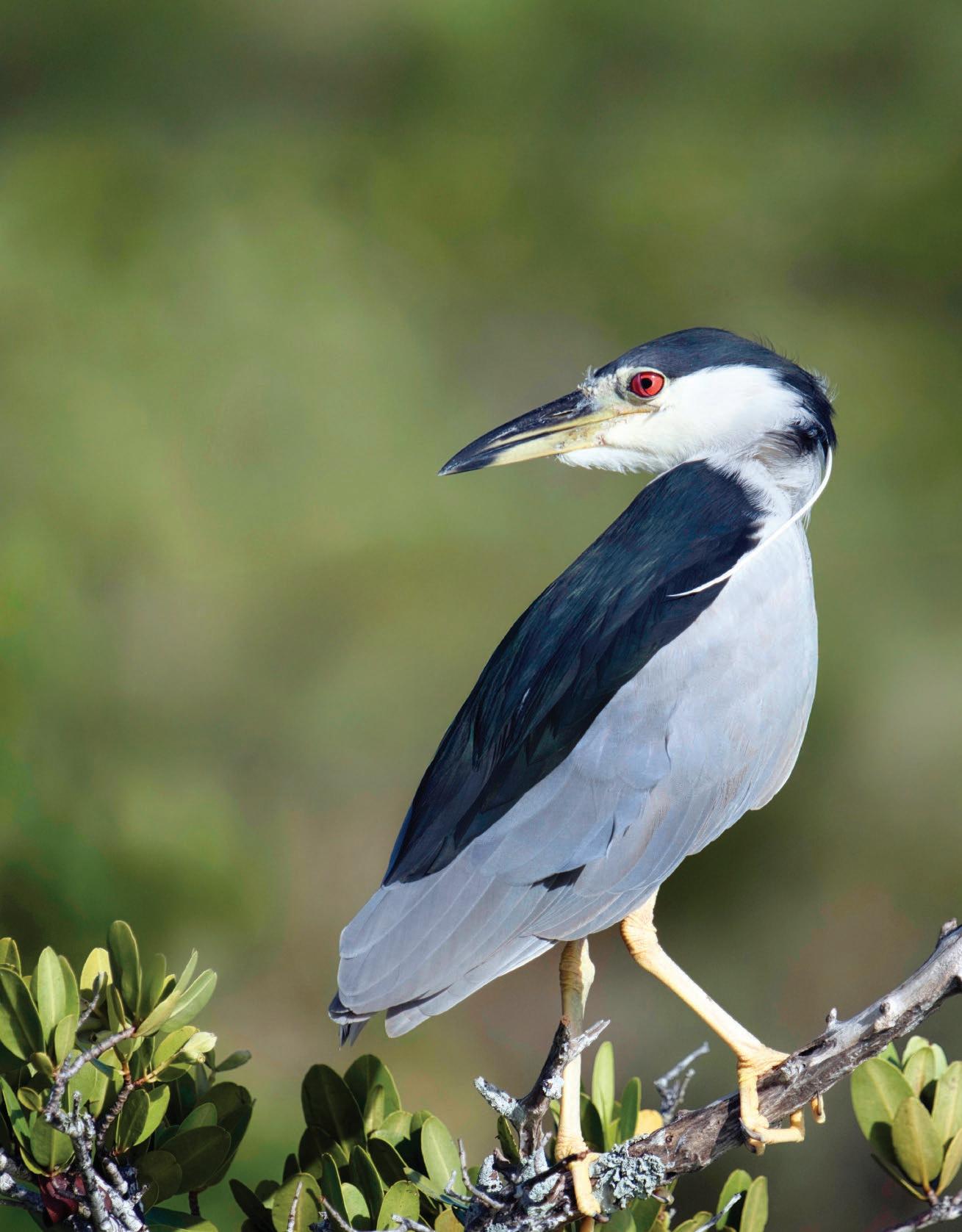


A small outpost in Narragansett Bay is worth saving for the birds
BOARD OF DIRECTORS
OFFICERS:
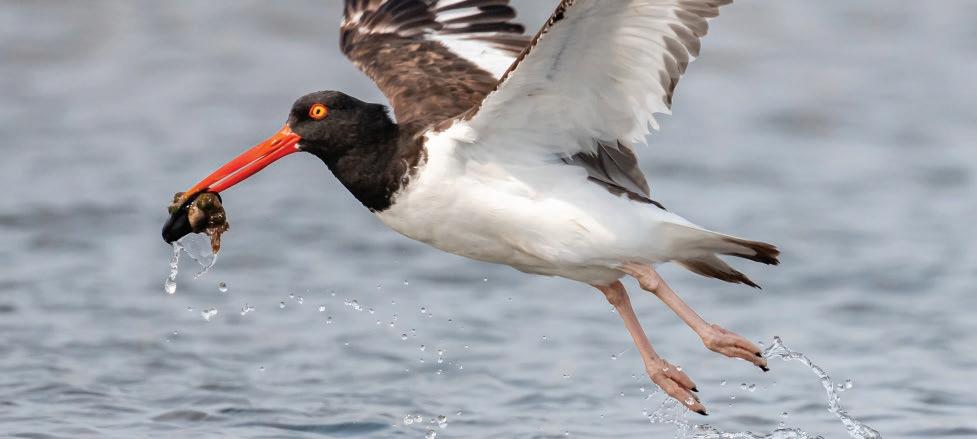
DIRECTORS:
Richard
Sara
Carol
Olinda
Emily
Jeff
Shawen
COUNCIL
President:
Nicholas
Christian
Trudy
Christopher
David
Peter
Samuel
Katherine
A.Max
Deborah
Terry
Robert
Suzanne
Steven
Frank
Julia
Charlotte
Everett
Frederick
Michael
Cynthia
Kim
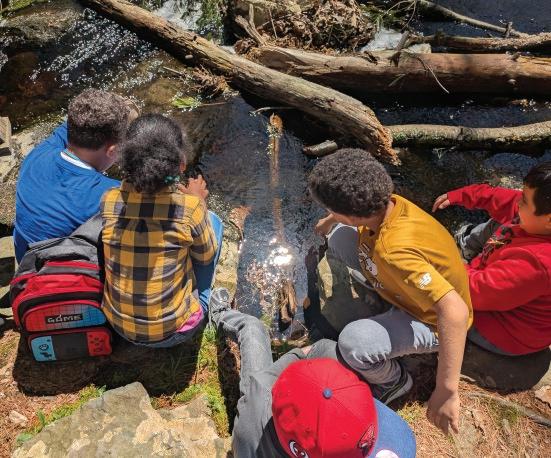

Audubon Society of Rhode Island 12 Sanderson Road, Smithfield, RI 02917 401-949-5454 www.asri.org
Executive Director: Jeffrey C. Hall
Managing Editor: Hope M. Foley
Contributing Writers: April Alix, Laura Carberry, Charles Clarkson, Hope Foley, Abbie Lahmers, Lauren Parmelee, Rebecca Reeves, Scott Ruhren, Katie Schortmann, Phoenix Wheeler.
Contributing Photographers: April Alix, Mary Ann Cofrin, Peter Fish, Peter Green, Janelle Hollis, Ed Hughes, Jasmine Jencks, Jason Major, Chris Powell, Scott Ruhren, Richard Staples, Janice Sullivan.
Cover: Black-crowned Night Heron by Mary Ann Cofrin
The Report is Audubon Society of Rhode Island’s newsletter, updating members and supporters on current news, policy issues, research and initiatives being led by the organization, staff, and volunteers.
We encourage your participation. Please send items that will be considered for publication to Managing Editor Hope M. Foley at hfoley@asri.org.
Please pass this copy on to a friend or recycle. Thank you.
As I write this letter, it’s the first day of Audubon summer camp—and it’s your generosity that has made this moment possible. Outside my window, I hear the excited voices of children exploring the trails, making new friends, and discovering the wonders of the natural world. For many of these campers, this experience feels like a rite of passage—a cherished summer memory in the making. Thanks to you, our dedicated education staff can work closely with small groups of children over several days, building meaningful connections to nature that will last a lifetime.
This year, your support has enabled us to offer more camp scholarships than ever before. Because of you, dozens of families were able to give their children the gift of outdoor exploration and learning, without facing financial barriers. You opened the door to a fun, educational, and life-changing experience for so many young people. And with camp registration filling up long before summer even began, it’s clear that if we had more space, we could welcome even more eager campers. Thank you for making this magic happen.
Your impact extends far beyond our camps and trails. Today also marks the close of Rhode Island’s 2025 General Assembly session. Thanks to your advocacy and support, Audubon and our environmental partners helped pass the Housing and Conservation Trust Fund Act—a critical step forward. This legislation creates a stable funding framework that will allow Rhode Island to protect key natural areas while also advancing affordable housing. Many see these two goals as competing, but we know better. With thoughtful planning, we can preserve biodiversity, protect sensitive habitats, and create green, livable communities where people and wildlife thrive side by side. This is your victory, one that reflects your commitment to a balanced, sustainable future for our state.
At the same time, I know many of you stood with us in urging passage of the bill which would limit the use of deadly anticoagulant rodenticides. While the House did not bring the bill to a final vote this session, your voices moved this issue forward in meaningful ways. The Senate Committee on
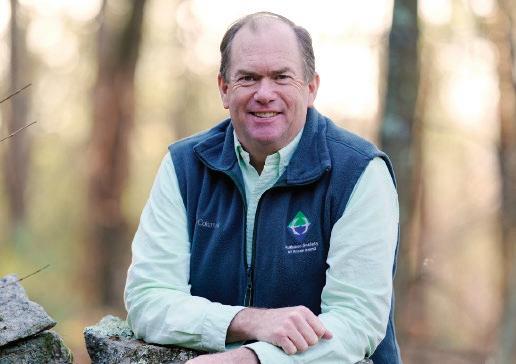
Environment and Agriculture passed the bill unanimously— a testament to the power of your advocacy. Together, we educated lawmakers about the grave dangers these poisons pose to owls, hawks, eagles, and other wildlife. We are not done. We have laid a foundation for future success, and we will return to the State House with renewed determination.
As we look ahead to the rest of the summer and fall, I hope you will continue to enjoy and engage with Audubon. Whether you visit a wildlife refuge, join a bird walk, participate in our new Field Naturalist Series, or simply pause to appreciate the sights and sounds of the season, know that your support strengthens the vital bond between people and the natural world. Please mark your calendar for Raptor Weekend on September 6 and 7—our annual celebration of birds of prey, made possible by supporters like you.
Finally, just as the seasons bring change, Audubon is also entering a time of transition. Three members of our senior staff—Kolby Purcell, Lauren Gordon, and Dr. Charles Clarkson—have moved on to exciting new opportunities. We are deeply grateful for their leadership and passion. Thanks to your steadfast support, we will soon welcome new members to the leadership team who will help guide Audubon’s next chapter.
Thank you for standing with us through these times of change and challenge. Together, we are building a future where both people and wildlife flourish— none of it would be possible without you.
Good birding,
Jeffrey C. Hall Executive Director
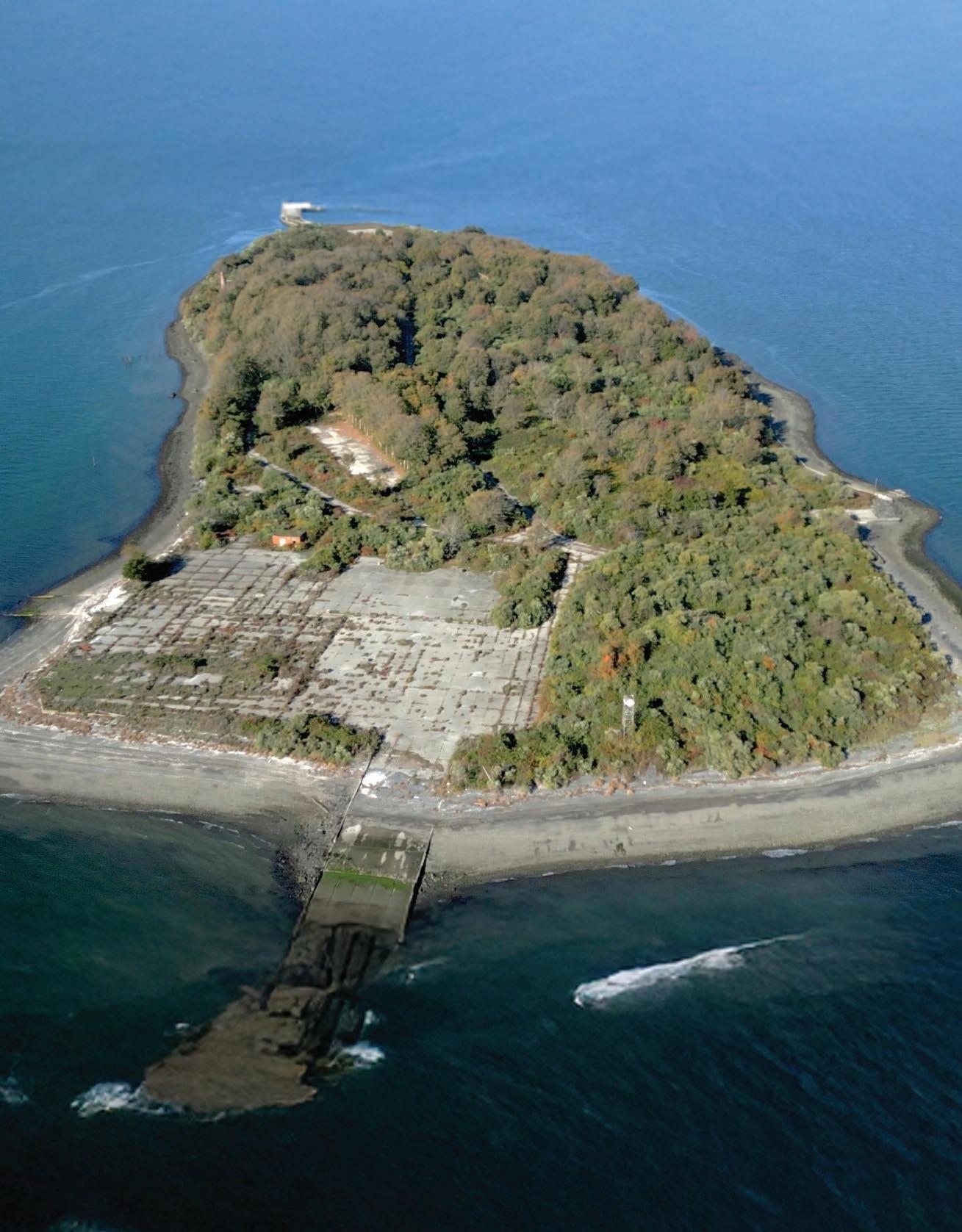
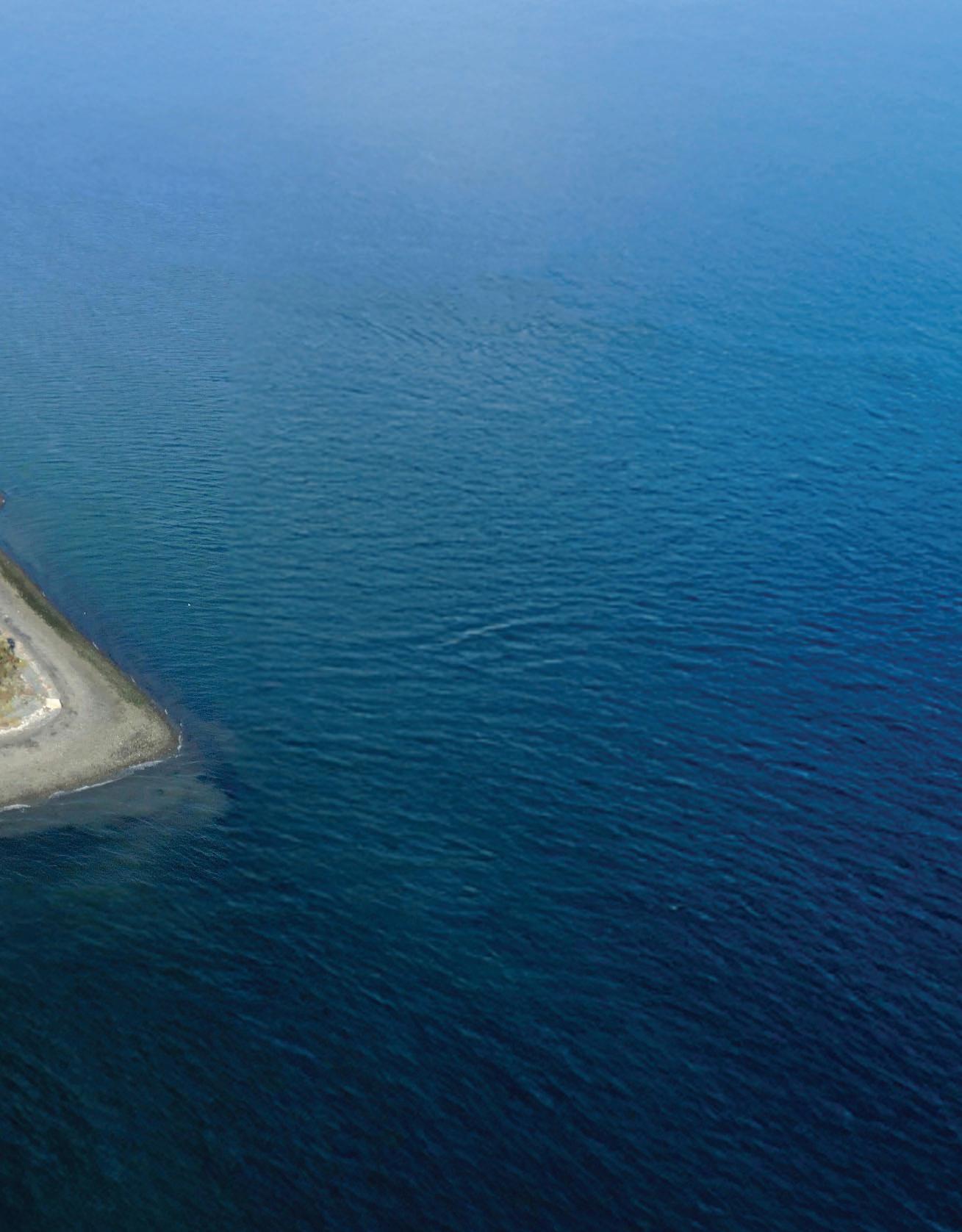
A
By Abbie Lahmers
From the majestic panoramic views on the cliffs of Beavertail State Park on Conanicut Island to the secluded birding opportunities Prudence Island offers, Rhode Island has no shortage of sojourns along the coast for residents and visitors alike to experience the wonders of nature. But some places, emphasizes Audubon Executive Director Jeffrey Hall, “need to stay wild.”
Gould Island is one such place.
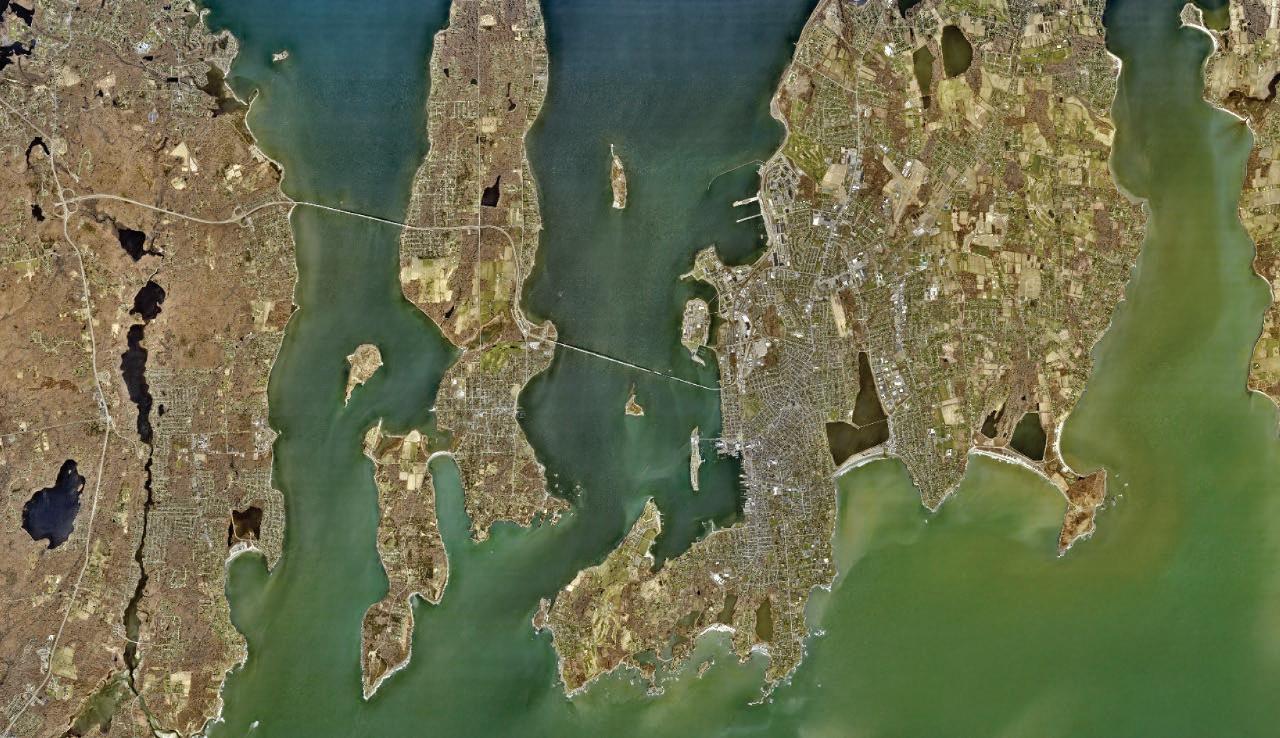
The small, uninhabited 53-acre parcel of land, which is part of Jamestown, in Narragansett Bay was requisitioned for the war effort in 1919. Seaplane hangars and barracks were constructed, and portions of land paved over to make way for concrete piers. It was used to store and refurbish torpedoes until the 1950s, before ownership of the southernmost 39 acres was transferred from the U.S. Navy to the State of Rhode Island. Since then, that portion of the island has been deed-restricted as a wildlife sanctuary.
The particular wildness of Gould Island isn’t without remnants of its human-altered past in the form of abandoned military structure ruins and swaths of concrete, and an ungraceful rewilding process that introduced non-native vegetation, but the colonial nesting birds that return year after year are unperturbed by, and even drawn to, some of these apparent blemishes. They seek one feature Gould Island has that can no longer be found in other island habitats scattered around the bay – undisturbed, protected space in which to breed.
As a mounting effort to open Gould Island to the public for passive recreation gains traction among towns surrounding Narragansett Bay, Audubon has made advocating for its preservation a priority. “Audubon manages wildlife refuges that we open to the public for people to get outside and enjoy,” Hall says. “We also have over a hundred properties that are closed to the public. There are places in the state where wildlife should exist without human disturbance so they can live peacefully.”
Since 1964, the Rhode Island Department of Environmental Management (RIDEM) has been monitoring Gould Island to collect data on the nesting activity of colonial breeding waterbirds – a
Rhode Island Department of Transportation, 2024.
term that encompasses “birds that nest in large aggregations typically on islands in coastal locations,” explains Audubon Director of Avian Research Charles Clarkson. Four species in particular have persistently returned to breed every year: the Black-crowned Night Heron, American Herring Gull, Great Black-backed Gull, and Double-crested Cormorant. The former three are listed in Rhode Island’s Wildlife Action Plan as species of greatest conservation need. A small breeding population of American Oystercatchers is also supported by the island – another species that makes the State’s list. This designation is in place to ensure these species are prioritized for conservation effort, in this case protected habitat in which to breed.
The steady decline of these species is captured in staggering data documented both regionally and across North America. Clarkson relays that the Black-crowned Night Heron population has seen a 24% drop across the United States from 2012 to 2022, and a 31% decline in Rhode Island in that timeframe. American Oystercatchers are gradually regaining a foothold in southern New England, with one to three breeding pairs present on Gould Island every year since first appearing in 1984, as they recover from a period of being hunted to extirpation, or local extinction, in the area.
Among the most beleaguered species are also some of the least beloved, and deceptively abundant, today – gulls. American Herring Gulls, which are immediately recognizable to anyone who’s spent time along the state’s coastline, have experienced a cumulative decline of 82% across North America from 1966 to 2021, according to Clarkson, while the Great Black-backed Gull population has dropped by 16% from 2012 to 2022 in Rhode Island, and by around 26% across North America. “The concern over the rapid decline of the Great Black-backed Gull both here and on the global scale has actually prompted conservation organizations such as the Interna-
tional Union for Conservation of Nature to suggest listing the species as vulnerable to extinction,” notes Clarkson.
These statistics are particularly poignant when considering the life cycles of these birds and their relationship with Gould Island – one of the last outposts in Narragansett Bay that supports their continued existence.
“They derive the majority of their food resources, which tends to be a combination of fish and invertebrate prey, from the water around those islands,” Clarkson relays, “and by nesting in these large colonies, they retain certain advantages, such as safety from predators in numbers, and information.” He elaborates that the birds watch one another – they see when an individual sets out to forage, and if its journey proves fruitful, they’ll depart in the same direction for food.
And though Gould is far from pristine in terms of vegetation, with invasive plants encroaching on the overgrown scrub-shrub habitat, the ample cover it offers allows the birds to congregate safely in an area free of coyotes and other predators. Even the concrete sections provide prime habitat for nesting gulls.
For decades, they’ve thrived in this environment without disturbance, but by nesting in tight aggregations, these species are also more vulnerable to threats that can result in outright nest failure. Clarkson indicates habitat loss and degradation, predation events, weather, and, not least of all, human disturbance, as major threats.
Unlike more terrestrial-based birds that are distributed on the mainland based on territoriality, Clarkson explains that for colonial nesters, “you're looking at a population of birds that is really concentrated in terms of its use of our state during breeding season. By removing even one site as a potential colony location, you could severely damage the statewide breeding population for these birds. The biological impacts are dramatic.”
The Jamestown Town Council has introduced a resolution to open the southernmost 17 acres of Gould Island to passive recreation, specifically overnight camping – a move that has been favored by multiple municipalities along Narragansett Bay, including Newport, North Kingstown, Portsmouth, Narragansett, and Middletown.
“This plan doesn't take into account any sort of wildlife considerations,” notes Hall. The Restoration Advisory Board (RAB) has suggested fencing off the forested center of the island for nesting, but the southern edge is the only area the birds have historically used. “That's not how these birds, which have evolved over millions of years alongside certain nesting habitat types, behave,” says Clarkson. “If you take that habitat away, they can't just pick up and move to a new one that they're unfamiliar with and nest successfully.”
Part of the proposal to deacquisition Navy land on Gould Island includes removing any hazardous waste that may be present, a remediation project that would fall under the purview of the U.S. Army Corps of Engineers. The state will have to hire a contractor to determine a management plan, and once that happens, Hall notes the importance of carrying it out with little disturbance: “Any remediation should be taken care of outside of nesting season.”
When that management plan goes out for public comment, Audubon will make a case for why the island should remain closed, informing residents on how crucial it is to preserve such an important ecological space. Since learning of the resolution last fall, Hall
Continued on page 28

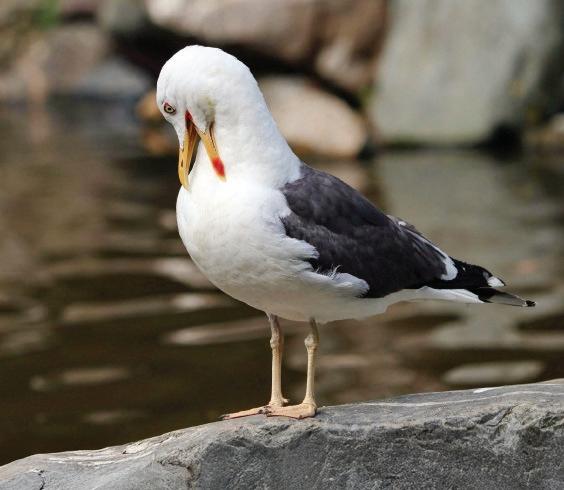
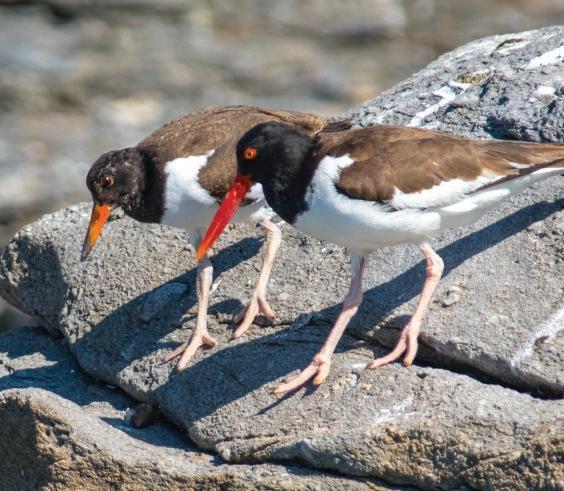
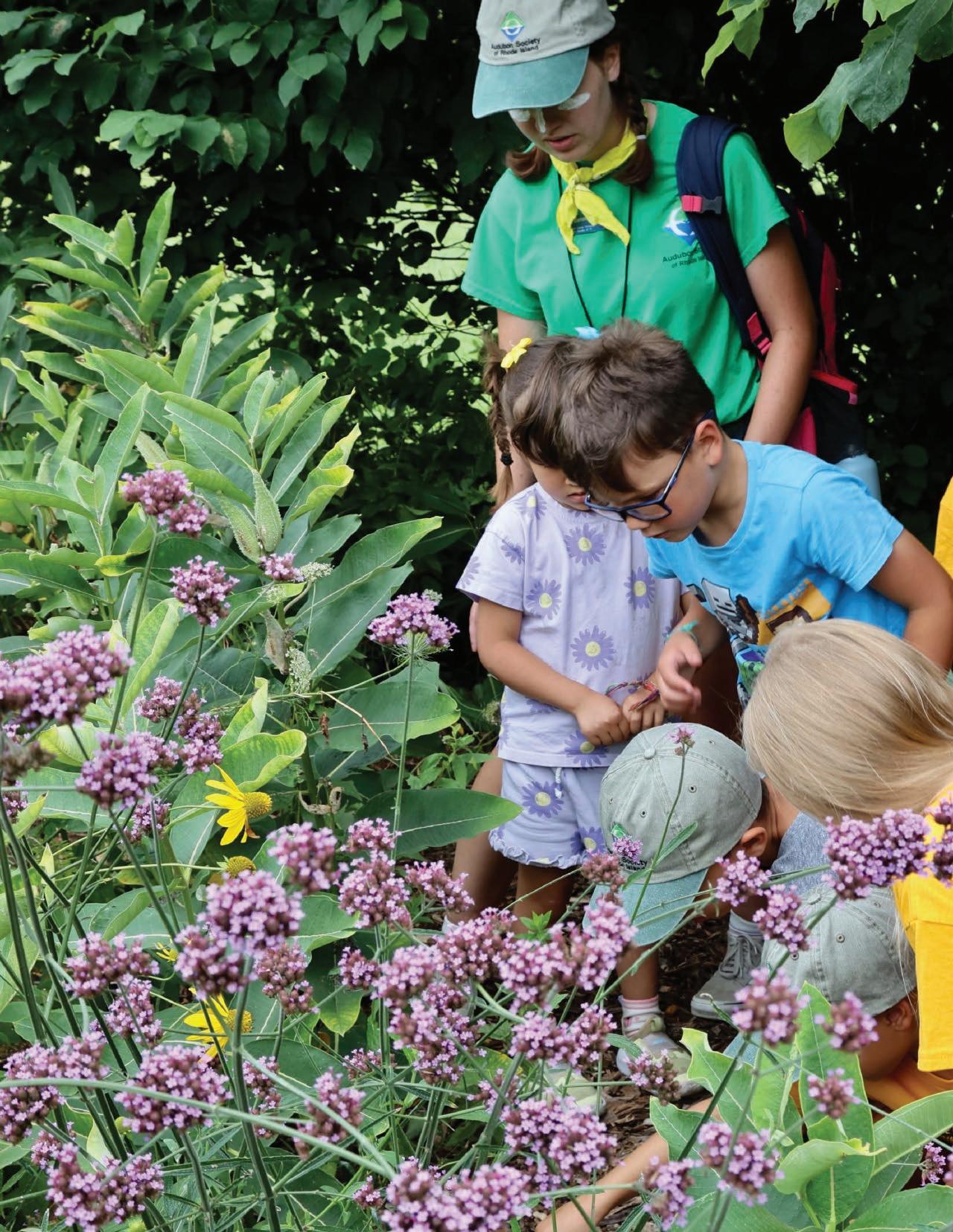
Aliving laboratory to study and support pollinator health, the Palmieri Pollinator Garden bustles with activity in the summer months. Along with insects and birds, young campers, students, families, and other visitors all enjoy the abundance of colorful blooms and wildlife in the garden.
Keep an eye out this summer as new plant species are added to increase biodiversity, provide more nesting material for birds, and create visual beauty year round.

• Caterpillars grow 5,000 times their hatch weight in one month!
• Bumblebees use buzz pollination by vibrating their bodies to make the pollen fall from the bellshaped flowers.
• If you come face to face with the shiny abdomen of a hovering carpenter bee, they pose no real danger. The yellow-faced males have no stinger and are simply determining if you are a threat to their turf. Simply walk on by, it’s all for show.
• Approximately 90% of caterpillars do not reach adulthood as many baby songbirds depend on these protein-rich insects for food.
• Almost 70% of bees are ground-dwelling. Their nesting habitat is easily disturbed and harmed by pesticides, lawn care, and other soil disturbance.
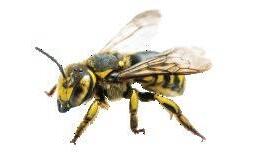
Register for a garden program today! Visit asri.org/calendar
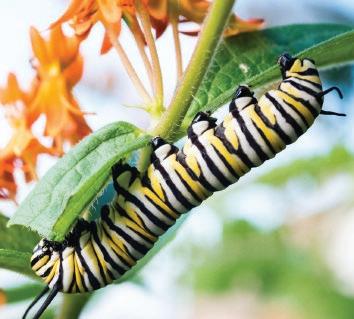
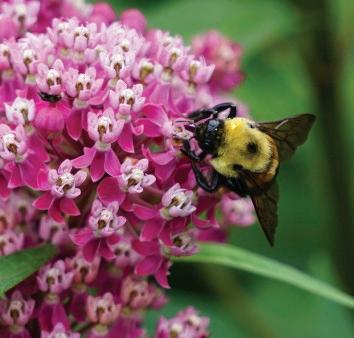
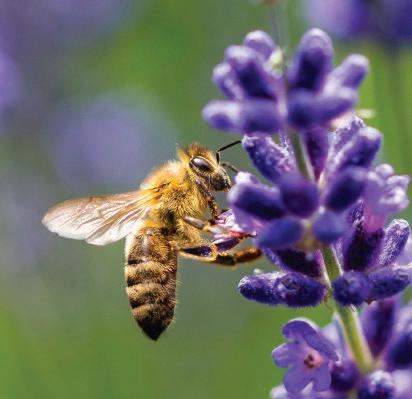
• Lecture: Protecting Pollinators in Your Landscape Powder Mill Ledges Wildlife Refuge Smithfield, RI; July 31, 2025
• Workshop: Designing a Wildlife Garden
Audubon Nature Center and Aquarium Bristol, RI; August 9, Oct. 18, 2025
• Native Seed Saving and Winter Sowing
Audubon Nature Center and Aquarium Bristol, RI; September 13, 2025
• Native Plants and Pollinators Lecture
Audubon Nature Center and Aquarium Bristol, RI; November 22, 2025

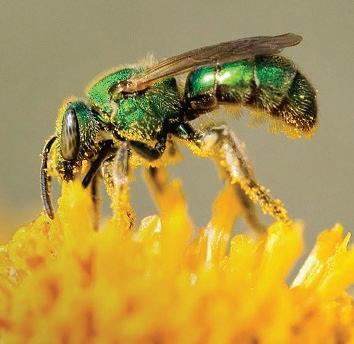
Hummingbird Moth (Hemaris diffinis)
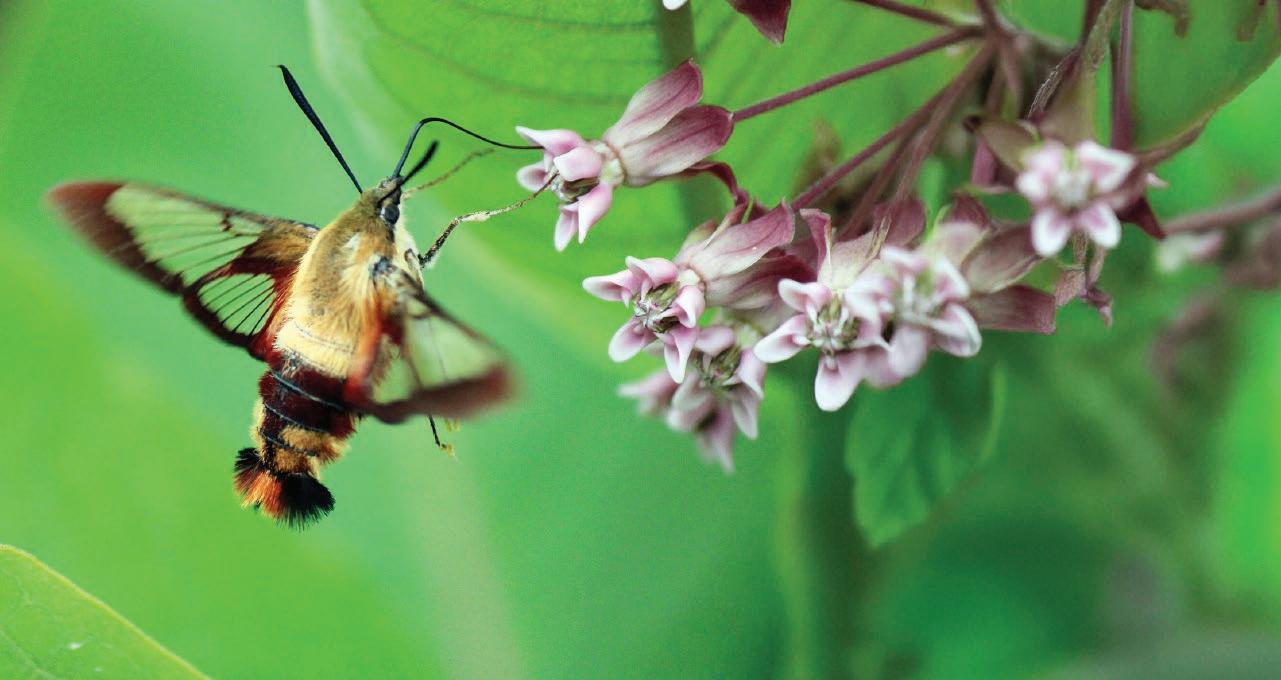
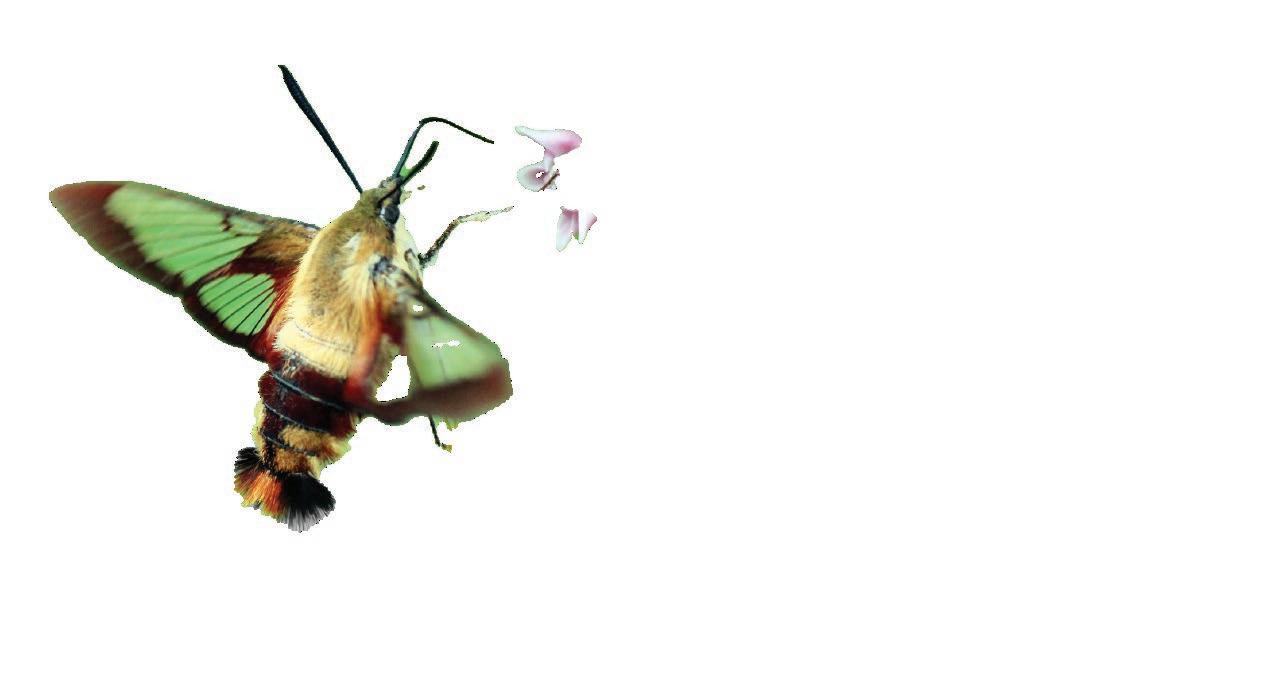
Furry, messy moths are the unseen heroes of pollination. They are more successful at transferring pollen to other flowers than some daytime pollinators. Bees have a limited travel range of a few hundred feet due to their nesting habits, moths have no nests and therefore can roam farther distances, increasing the genetic diversity of plant communities.
While bees gather pollen neatly on their hind legs, moths are a bit more chaotic. Bees are saving pollen for their larvae; most moths are not. With the exception of the yucca moth which is believed to be an “intentional” pollinator, most moth species visit blooms only for nectar, and their messy pollination skills are simply an aftereffect of their foraging for food.
As many are nocturnal, most people do not witness the diversity of this family of insects. If you want to be intentional about creating a garden as a space for moths, here are some tips: Turn off your lights at night. Artificial light is not just harmful for migratory birds, it also disturbs insect navigation and their circadian rhythm, interferes with mating, feeding and increases predation.
Those moths flying into your porch light are aiming for the treetops, following the light of an artificial moon. While enamored with that light, they can starve and are distracted from what they should be doing – finding mates and visiting flowers and host plants.
hOW
• Create dark zones on your property. Shade the lights from your neighbor’s house with trees and shrubs.
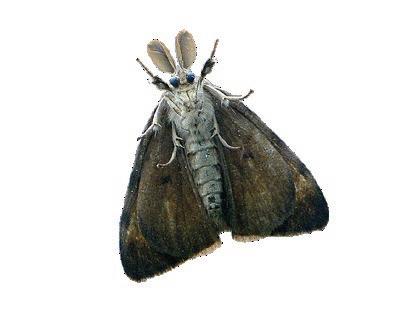
• Use native plants in your yard. Native trees are important moth caterpillar food.
• Choose white, light-colored and fragrant flowers to attract moths.
• Use “host plants” for moth larvae to feed on. The oak tree is a host plant for over 400 species of winged insects, including butterflies and moths. Visit https://plantfinder.nativeplanttrust.org for a listing of other host plants.
• Create soft landings under trees. Planting native ground cover under your trees creates pupation sites, this can protect caterpillars that have fallen from the treetops.
• Leave logs for caterpillars to borrow into when it’s time to pupate.
• If you implement these steps, “leave the leaves” in the fall and spring, and avoid spraying chemicals on your gardens and trees, you will be inviting moths and fireflies into your landscape.
• Bats and Beer; Fisherville Brook Wildlife Refuge, Exeter, RI; July 25, 2025
• Touisset Full Moon Hike
Touisset Wildlife Refuge, Warren, RI; August 8, 2025
• Bones and Brews – Spooky stories, cold beers and a chilly night hike!
Caratunk Wildlife Refuge, Seekonk, MA; October 24, 2025
• Beavers of Fisherville
Fisherville Brook Wildlife Refuge, Exeter, RI; November 4, 2025
Owl Prowls
• Powder Mill Ledges Wildlife Refuge, Smithfield, RI; Oct. 6, Nov. 6, 2025
• Fort Wildlife Refuge, North Smithfield, RI; Oct. 7, Nov. 5, 2025
• Caratunk Wildlife Refuge, Seekonk, MA; Oct. 17, 2025
• Emilie Reucker Wildlife Refuge, Tiverton, RI; Nov. 7, 2025
• Fisherville Brook Wildlife Refuge, Exeter, RI: Nov. 14, 2025
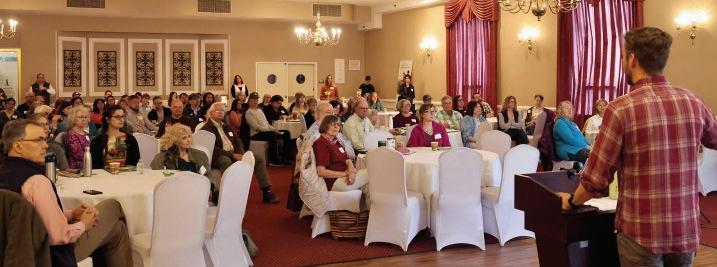
By Katie Schortmann, Pollinator Outreach Coordinator / Environmental Educator
In April, Audubon hosted the second annual Transforming the Landscape event at the Quonset O Club in North Kingstown. Over 100 attendees gathered to learn from experts about insects, pollinators, native plants, and stormwater management.
Keynote speaker Nathan Lambstrom, owner of Lambstrom Garden Ecology, is a landscape consultant and URI instructor who spoke about the importance of understanding plant growth habits when designing an ecologically-minded garden. A well designed wildlife garden is one that will keep neighbors and pollinators happy for years to come!

Audubon Society of Rhode Island Named Endowment Funds
The Audubon Endowment is a permanently restricted fund that, by law, exists in perpetuity. Because the Audubon Endowment is invested, it allows for long-term stability, fiscal responsibility, and financial viability that keeps Audubon a vibrant and growing organization.
It also enhances our credibility, relieves pressure on fund raising, allows program expansion, and provides independence.
Donations of $10,000 or more to the Audubon Endowment can be recognized by a named designation, either for an individual, family, or a cause you believe in.
Audubon Society of Rhode Island Named Endowments
Aust-Capron Memorial Fund
Barter-Moore Fund
Edith Becker Fund
Mary Catherine Rogers Beckett Fund
John Brezinski Memorial Fund
Bristol Education Center Fund
Caratunk Fund
Mary B. Cottrell Fund
Severyn Dana Fund
Davis Memorial Wildlife Fund
Norman A. Deslauriers Fund
Dickens Farm Fund
Patricia Meagher Dwyer Conservation Fund
John Raleigh Eldred Fund
Bayard Ewing Fund
Fisherville Brook Fund
There were eight students who presented research posters from the URI Bee Lab, Providence College Bonoan Lab, and the URI Biocontrol Lab. Guests met with organizations such as the RI Wild Plant Society, 15 Minute Field Trips, Natural Resources Conservation Service, and Barrington Pollinator Pathways. Attendees left the event with new connections and expert information, armed to create wildlife habitat in their communities. keep backyards buzzing
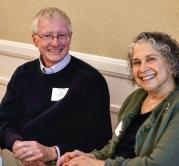
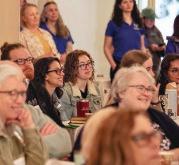
From top: Keynote speaker Nathan Lambstrom. Dr. Steve Alm, a speaker from the URI Bee Lab, and Audubon Council of Advisors Member Terry Meyer. Gathered attendees at the symposium.
More data on existing garden habitat allows Audubon to make targeted efforts to create more of this essential habitat. Take the pesticide free pledge and put yourself on the map! Visit asri.org/pollinators
Fort Nature Refuge Fund
Grout Memorial Fund
Alice O. Harris Fund
Jonathan H. Harwood Fund
Hicks-Borden Fund
Priscilla J. Hollis Fund
Mary C. Kellermann Endowment Fund
Walter Hammond Kimball Fund
Crawford N. Kirkpatrick III Fund
Margaret Robinson Knight Fund
Kimball Memorial Garden Stewardship Fund
Kay Kinsey Fund
Kraus Wildlife Fund
Henry J. Larkin Wildlife Preserve Fund
Lorraine Leaney Fund
Little Rest Bird Club Fund
Lonesome Swamp Fund
Edward B. and Phoebe W. McAlpine Memorial Preserve Fund
Constance McCarthy Fund
McKenzie Wildlife Fund
George B. Parker Fund
Powder Mill Ledges Fund
Prudence Island Fund
Susan M. Romano Memorial Fund
Elton Sanford Fund
Alicia Perry Seavey Family Fund
South County Fund
Everett F. Southwick Fund
Touisset Marsh Fund
Viall Memorial Library Fund
Mrs. and Mr. Dudley A. Williams Memorial Fund
For more information contact Jeff Hall at jhall@asri.org or (401)-949-5454 ext. 3017.
By Phoenix Wheeler (they/them), Director of Advocacy
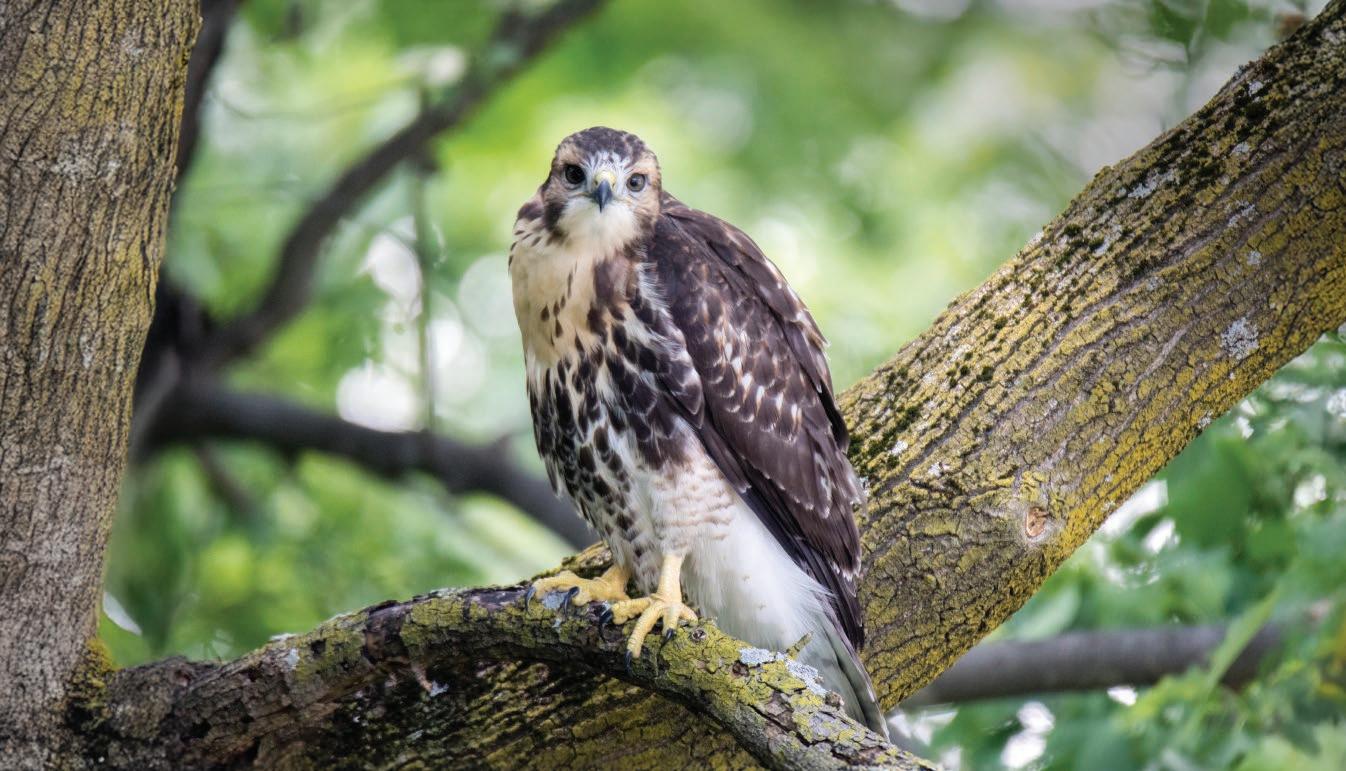
The work we have done together deserves to be celebrated
From its founding to protect birds from slaughter in 1897 to the Act on Climate legislation in 2021, Audubon Society of Rhode Island has a long and historic record of successful advocacy. Every victory that has protected birds and their habitats has come via collaboration with advocates like you.
Our work may take years of committed and unwavering advocacy to see legislation passed, but our members and supporters have always been steadfast, responsive, and have provided the cornerstone of our efforts.
Jumpstarting a dormant commission, the Housing and Conservation Trust Fund Act has been signed into law. An active commission will now be able to fund more effective and equitable projects for affordable housing that includes land conservation.

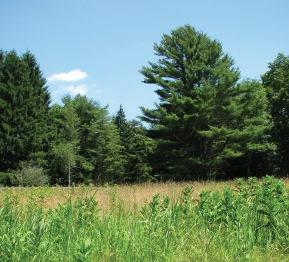
Senate bill (S-651) passes, but companion bill (H-5704) stalls in the House
Bills rarely, if ever, pass before their third year in Rhode Island. Passing environmental legislation is often a hard-fought battle. We are immensely proud of the momentum achieved this year in banning dangerous rat poisons. These anticoagulant rodenticides don’t just kill rodents; they also kill birds of prey.
In two short years, the Senate bill (S-651) passed the Senate 35-0 with bipartisan support. That kind of momentum only comes from our hard work together, educating dozens of legislators on the need to save raptors. Audubon led the campaign as over 1,500 members and supporters called, emailed, signed petitions, and sent letters to their legislators in support of a ban. Volunteer nights at both the Audubon Nature Center and Aquarium in Bristol, and Headquarters at Powder Mill Ledges in Smithfield have encouraged the growth of a new core group of advocates, joining the many who have worked with us in the past.
As our movement grew, organizations such as Save the Bay and Clean Water Action joined as partners, offering their support. Two years ago, anticoagulant rodenticides were relatively unknown toxic pesticides. Because of advocates like you, they have become a much-discussed public concern.
While the house companion bill (H-5704) was not brought up for a vote, we received positive feedback from legislators daily about the number of constituents reaching out. The bill, which just months before seemed unlikely to pass, was seriously considered.
Audubon is proud of our progress and will continue to strongly advocate for a ban on dangerous rodenticides and protecting birds of prey.

Recent campaigns have brought new groups of volunteer advocates, joining the many who have worked with Audubon in the past.

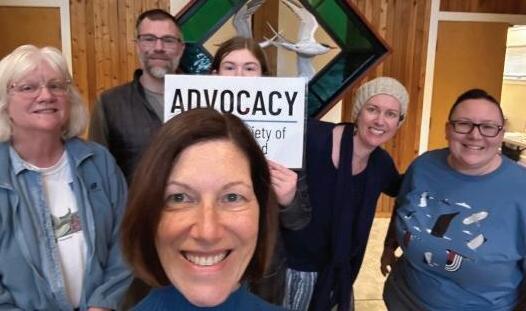
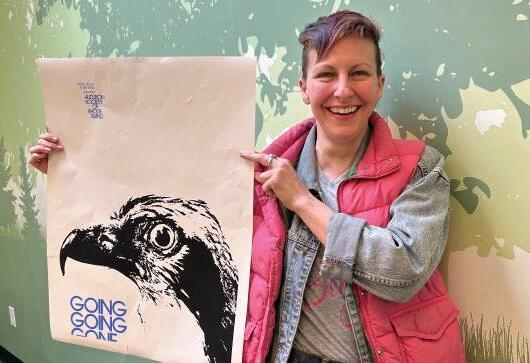

On May 27, three Peregrine Falcon chicks (called eyases) were banded at their nesting box atop the "Superman building" in Providence. Bird banding allows scientists to track their life history, migration, and reproductive behavior. These three eyases raised the total number of banded nestlings to 80 since the year 2000.
Wildlife photographer Peter Green was on hand to capture the event, also snapping images of the concerned Peregrine parents, swooping overhead. This year's adult male is banded, and Green was able to photograph his banding code, 88/BU. From that code, we learned the male adult had previously been banded as a nestling by Joe Zbyrowski at the same exact location in 2023. It was a homecoming.
Audubon celebrates the large number of young Peregrines successfully banded over 25 years of the nesting box initiative, and the productive nesting season of 88/BU.
Thank you to Joe Zbyrowski for once again banding this year's brood, and Peter Green for taking such amazing photos.

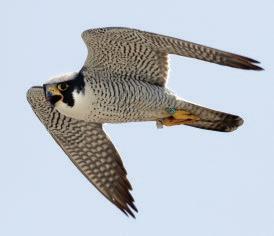

In 2008, Donna-Jean Rainville made a generous gift to the Audubon Society of Rhode Island through a charitable gift annuity.
An experienced fund development and not-for-profit consultant, she was also an Audubon board member at the time.
Today, she still considers this gift a wise choice and refers to it as a triple play legacy gift.
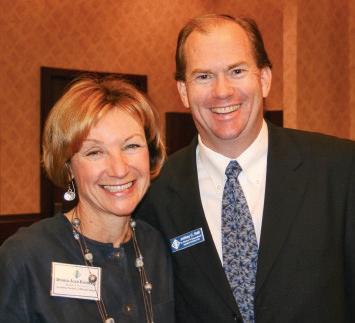
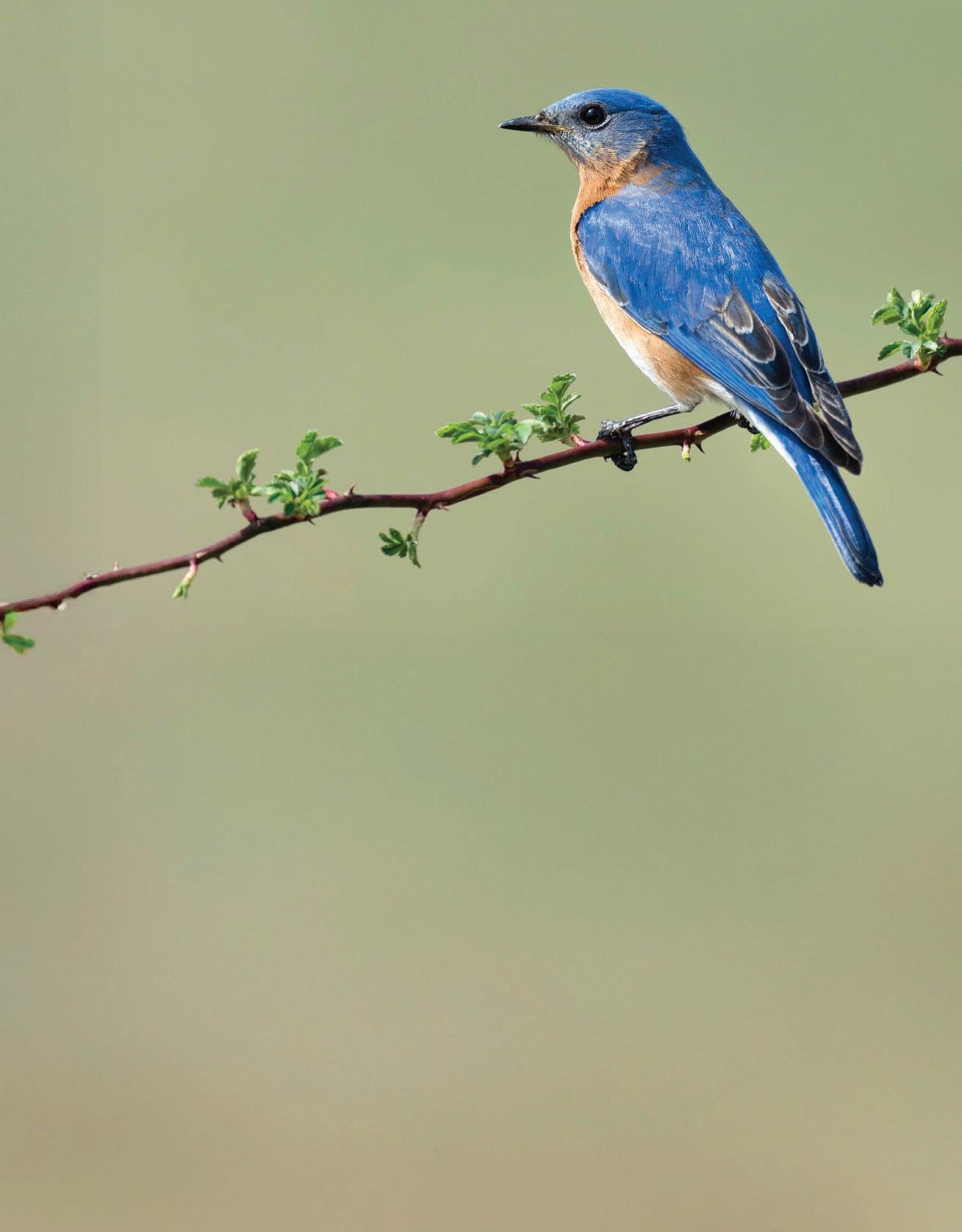
A method of giving that allows you to contribute to Audubon now, and in return, the organization agrees to pay you a fixed amount each year for the rest of your life. The balance is then used to support Audubon’s mission. You can also qualify for a variety of tax benefits, depending on how you fund your gift.
A deferred gift annuity allows you to postpone your first payment to a later date. When Rainville made her gift to Audubon, she deferred her funds to 2014, when she retired.
“Gift annuities are an integral part of my philanthropic giving and financial planning,” Rainville explained. “I’ve used them to help my favorite causes since my first gift in 2006 to my university. The benefits are many.”
Rainville outlined her reasoning, explaining what the annuity has enabled her to do:
• Give a larger gift to Audubon and other favorite causes than I otherwise would be able to make.
• Gain additional tax benefits during the time I was working by deferring annuities to my retirement.
• Grow the principal amount of my deferred annuities. For example, though I have been receiving an Audubon annuity for 11 years since my retirement, the principal gift sum remains larger than my original gift!
• Continue to gain tax benefits after retirement because a portion of my benefits are tax free.
• Take advantage of the recent one-time tax avoidance opportunity to transfer $50,000 in assets from my IRA to create a gift annuity and reduce my Required Minimum Distribution.
• Utilize gift annuity assets as part of my overall asset allocation investment plan to add to a guaranteed annual income for life.
• The opportunity to offset capital gains taxes by donating appreciated stock.
“It’s a triple play of larger gifts than I otherwise could make,” Rainville said. “It’s a tool for personal financial management and most importantly, provides a legacy gift to Audubon, the other causes I have chosen, and individuals who will be assisted.”
For more information, please contact: Jen Cleland, Director of Development 401-949-5454, ext. 3018 or jcleland@asri.org
By Dr. Scott Ruhren, Senior Director of Conservation
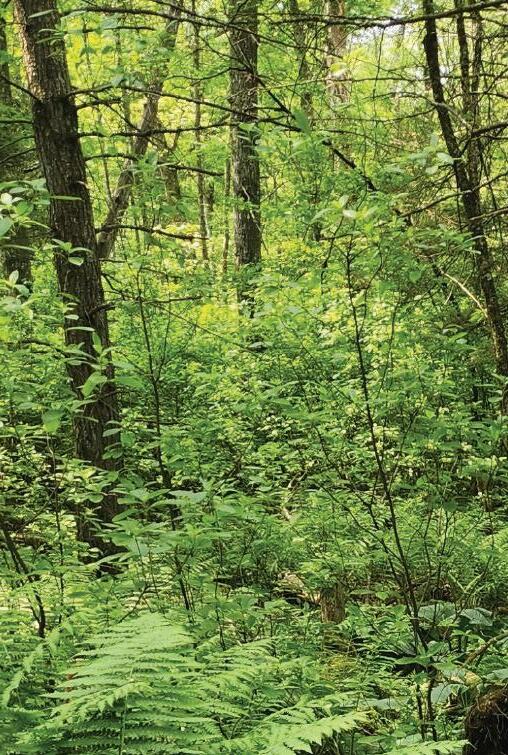
One of Audubon’s conservation goals is to keep connecting smaller areas of protected habitat, creating larger expanses that many species of wildlife need to thrive.
EI am at ease knowing that this precious land and wildlife habitat will be protected for the future. – Phyllis Smiley “ “

arly this year, Audubon purchased 36 acres in Coventry with the assistance of a State Open Space Grant. This land, formerly known as the Rice City property, has been added to Audubon’s Perched Boulder Woods Wildlife Refuge which was created in 1981. This matrix of four connecting properties has created a 113-acre refuge in an area of shrinking forests due to rapid development of housing and paved roads.
The landowner, Phyllis Smiley, knew that she wanted to protect the land and worked with Audubon to make sure it would be preserved in perpetuity.
“My father, Cecil C. Long of the original company still known as Long Realty, received the parcel of land in Rice City as part of a commission by a landowner, possibly in the 1960s,” Smiley said. “My father then passed down the land to my mother, Filomena C. Long, in 1976, which she gifted to me in 1986.
As taxes in Coventry increased, I thought more and more about selling the land, but I did not want it to be developed. I have always wanted to keep the land as natural habitat and a safe haven for the wildlife.”
Lynn Smiley of Smiley Real Estate, LLC, knew of Phyllis’s wishes, and reached out to Audubon to start the conversation. The parties were able to produce an agreement that is beneficial to both. “I am thankful to the Audubon Society for their purchase,” Phyllis continued. “And I am at ease knowing that this precious land and wildlife habitat will be protected for the future.”
Perched Boulder Woods lies within the "Last Green Valley," a critical area designated by RI, MA and CT Audubon organizations, the Natural Resources Conservation Service, RI Department of Environmental Management and others, for research, monitoring, and forest protection.
Low spots in the terrain, likely kettle holes, contain functioning vernal pools. Nearly 100% of the parcel is forested with a canopy of oaks and white pine, occasional pitch pine and less abundant hardwood species. The understory is thickly vegetated with huckleberry and blueberries, evidence of the dry, low-nutrient acidic soils in the uplands and sweet pepperbush in the wetlands. About 70% of the property is swamp, valuable forested wetlands that support numerous wildlife species. Many birds nest or migrate through these varied habitats including Brown Creeper, Northern Waterthrush, Red-shouldered Hawk, Wood Thrush, Red-eyed Vireo and Black-and-white Warbler.
Due to the sensitive habitat and wetlands, this property will not have public access.
For over 100 years Audubon has been a trusted partner to landowners, tailoring permanent conservation plans for families. Contact Scott Ruhren, Senior Director of Conservation, to discuss ways you can work with Audubon. Email sruhren@asri.org or call 401-949-5454 ext 3004.
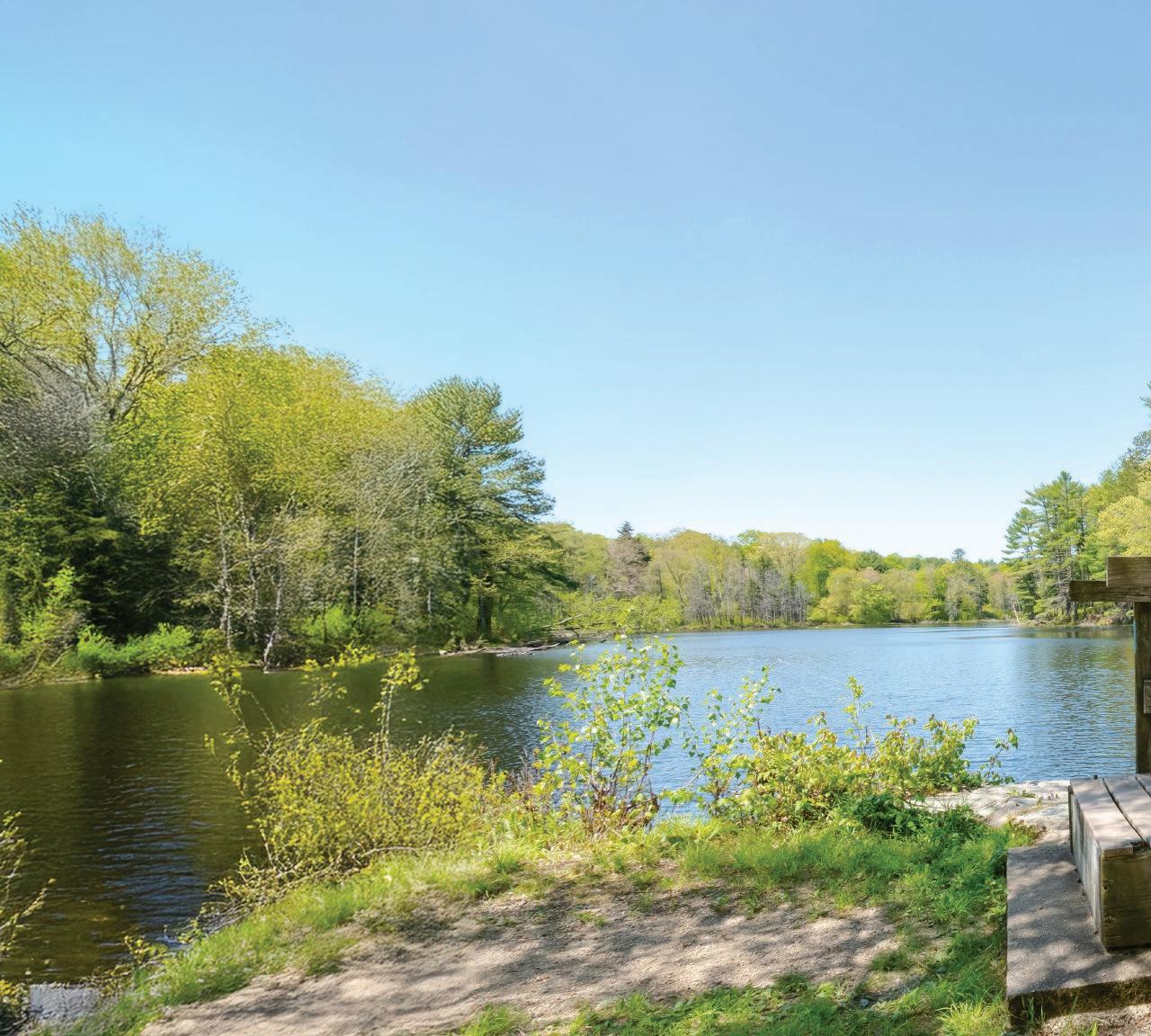
Audubon’s largest public property lies in rural Exeter with over 1,000 acres. Fisherville Brook Wildlife Refuge is a popular destination for birders, hikers and families, offering trails through diverse habitats as well as rustic bridges over streams and a small waterfall.

Sip local brews while learning all about our native bats, then head out on the trails in search of these winged creatures. July 25, 2025. Register at asri.org/calendar.
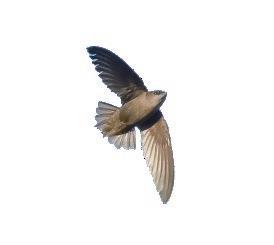
Look for Chimney Swifts over the fields and pond this summer, swooping in on their next meal. Learn more about these birds, their decline, and the nesting tower that was built for their use. The nesting site with new signage is located off the blue trail near the cemetery.
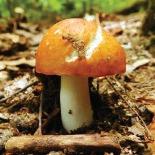
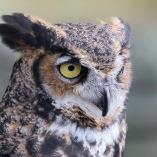
Learn how to identify mushrooms, including edible ones. Begin with a lecture on mushroom identification, then head out with an expert to find them growing in the wild. Sample some tasty dishes prepared using cultivated "wild" mushrooms too! August 23, 2025. Register early at asri.org/calendar.
Audubon offers birthday parties for children at Fisherville Brook. Parties include guided outdoor explorations and festivities in the nature center. Invite an owl to join the fun! Plan a celebration at asri.org/birthday-parties.
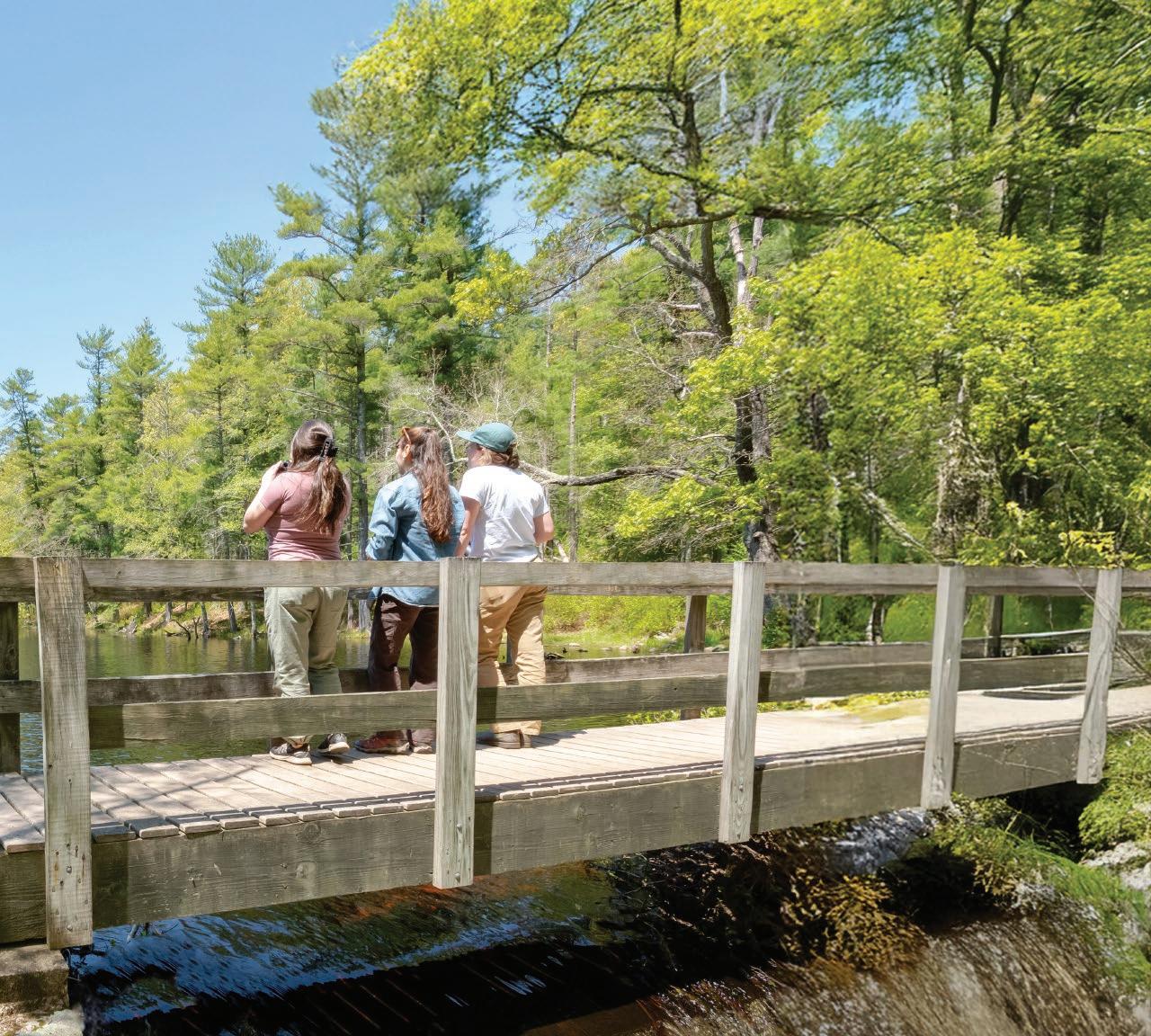
Please Note: GPS systems are not always accurate to Fisherville. Please use the directions provided at asri.org/hike/wildliferefuges.
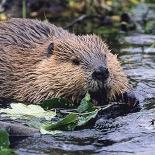
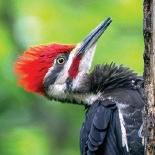
Join an evening walk and discussion regarding the resident beavers at the Fisherville Brook Pond. Observe beaver dams, lodges, and hopefully the beavers themselves! These creatures become active at dusk, so you may be able to see these engineers at work. November 4, 2025. Register at asri.org/calendar.
Pileated Woodpeckers are becoming more and more common at Fisherville Brook.
See if you can spot one of these loud and large woodpeckers!

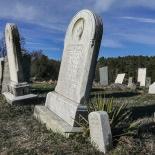
Due to its size and diversity of habitat, many mammals call Fisherville home: black bear, bobcat, red fox and grey fox, fisher, otter, mink, long-tailed weasel, skunk, opossum, and coyote.
Found along the blue trail, a captivating historic cemetery is often used by turtles as a nesting spot. As not to disturb these nests, and to protect the fragile stone grave markers, we ask visitors to enjoy the beauty of the area from the trail.
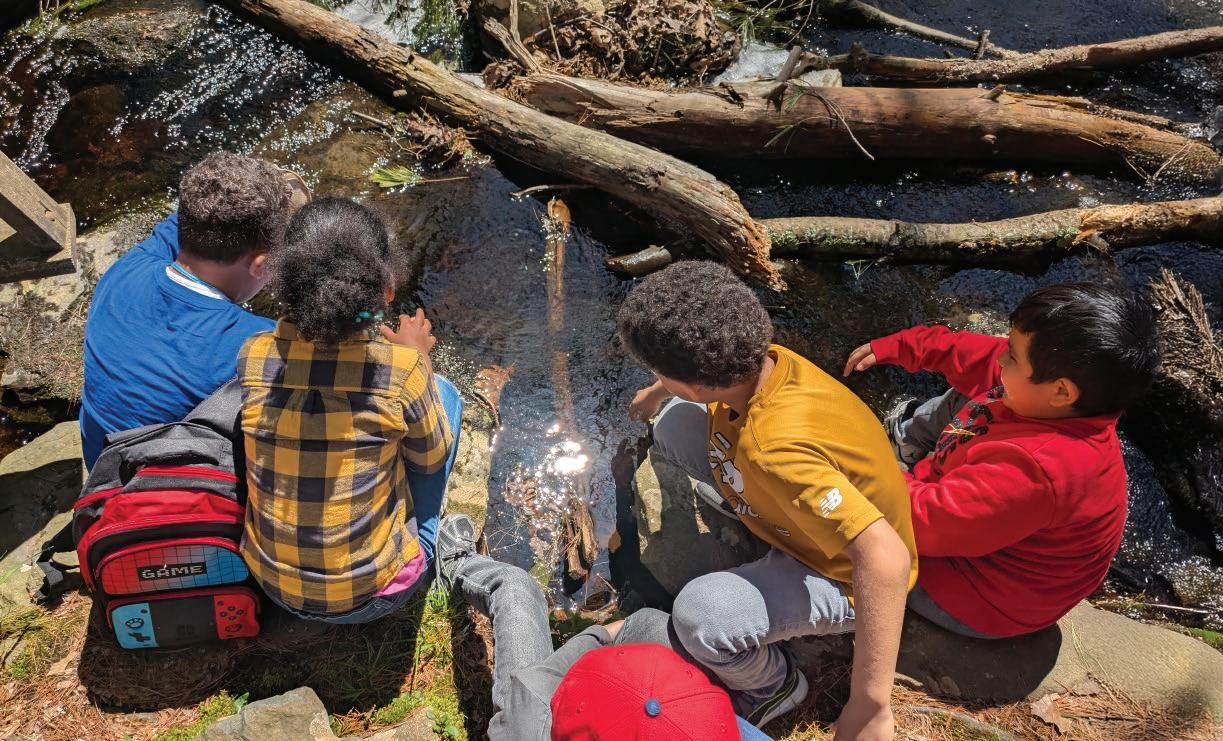
By April Alix, Associate Director of Education
For over 20 years, Audubon educators have worked closely with teachers in Pawtucket public schools to provide science programming to all third graders in both the classroom and in the field, at no cost to the schools. Topics span from learning about owls in Rhode Island, to the life cycles of native animals, and lessons on how ecosystems are connected.
Students travel to the Audubon Nature Center and Aquarium in spring for a hands-on, experiential field trip that explores various habitats found in the state. These trips are designed to welcome Pawtucket students with a nature hike, a live animal interview, and time spent learning from the aquarium exhibits. Audubon serves 500 to 700 Pawtucket students annually through this program alone.
Free science programs were extended to two Providence elementary schools this year as Audubon was invited to take part in a pilot project-based learning experience. The curriculum focused on specific science topics and culminated in a discovery walk at an Audubon wildlife refuge.
At one elementary school, 92 second graders focused on trees throughout the year. Audubon led programs on native species in Rhode Island, the difference between coniferous and deciduous trees, monitoring the seasonal cycles of the trees, and discovering what wildlife species rely on trees for food and shelter. Students took walking field trips with Audubon and the Providence Urban Wildlife Conservation Partnership to local parks, including Neutaconkanut Hill,
where they were able to study trees within their own neighborhoods. The program concluded with a field trip to Caratunk Wildlife Refuge for an exploratory walk where they compared and contrasted the species on the refuge with those found within their neighborhoods.
Additionally, 78 fourth grade students studying earth sciences explored Powder Mill Ledges Wildlife Refuge through a geology lens, where they completed experiments on erosion, runoff, soil composition, and rock formations.
Help Audubon expand science initiatives in Rhode Island's city communities. Visit asri.org/donate.

On April 22 staff from the Stormwater Innovation Center partnered with Building Futures – Rhode Island in Roger Williams Park. Students in the Building Green Futures class learned the fundamentals of stormwater management, how green infrastructure works, and why it's critical for protecting water quality. They also gained hands-on experience inspecting stormwater sites - learning how to identify signs that a system needs maintenance or is not functioning as intended.
Building Futures provides apprenticeships for young adults in the building and trade fields. This five-week program allowed participants to explore careers in the environmental field.
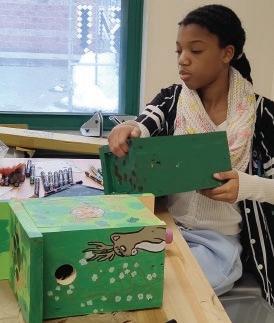
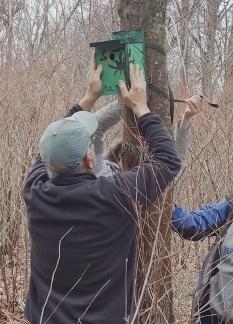
In March, Audubon teamed with the Woonasquatucket River Watershed Council and local residents to install 16 nesting boxes along the greenway in Providence. Often neglected in larger conservation projects, urban habitats are vital sanctuaries for migratory and resident birds. These nesting boxes will encourage nesting of native wrens, nuthatches, and chickadees and create opportunities for residents to observe these species. Thanks to AAA Northeast for assistance in constructing these boxes.
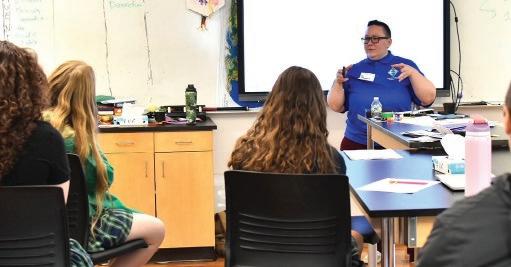
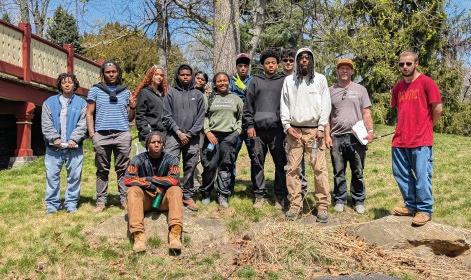
Silvermoon Mars LaRose, Assistant Director of the Tomaquag Museum, led a discovery walk on May 7 at the Maxwell Mays Wildlife Refuge in Coventry. The information shared was captivating and inspiring. Audubon thanks Silvermoon for providing greater awareness of local history and sharing cultural knowledge of our native plants and habitats.
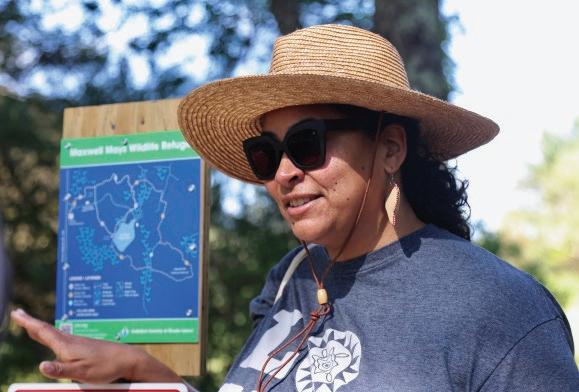
The Lincoln School in Providence invited Audubon Director of Advocacy Phoenix Wheeler (they/them) to visit the senior class on Earth Day in April during a week of environmental activities hosted by Lincoln's Environmental Action Group (LEAG). Wheeler provided workshops on environmental campaign organizing, spoke on a panel with local, state, and federal leaders, and invited students to join advocacy efforts. Audubon also provided internship experiences as part of a senior capstone project at the Nature Center and Aquarium.
By Laura Carberry,
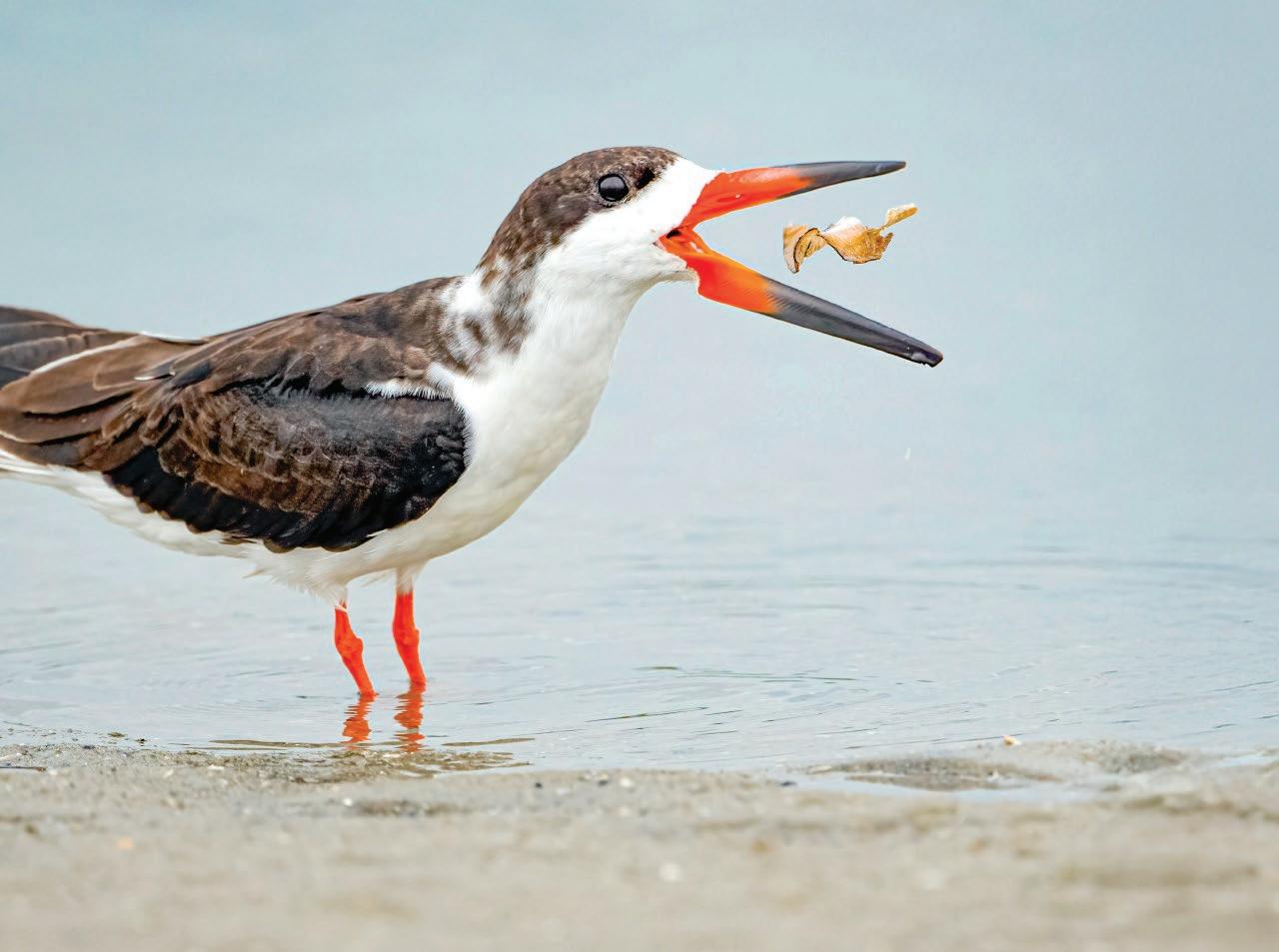
Photos by Peter Fish
The Black Skimmer (Rynchops niger) is a distinctive shorebird found along Rhode Island's coastal habitats in the late summer and early fall. With striking black-and-white plumage and unique feeding behavior, this bird is known for its specialized adaptations that enables it to thrive in this coastal environment.
Amedium sized tern-like bird, the Black Skimmer has very long wings and a bright black and red bill in which the lower mandible is much longer than the top. It is the only bird found in North or South America that feeds by skimming the water’s surface. It flies low with its long lower mandible extended, touching the water to detect fish. Upon contact, the upper mandible snaps shut, capturing the prey. Skimmers eat a variety of fish that are usually under five inches long, including herring, mummichogs, smelt, and more.
Skimmers are largely crepuscular, meaning they are most active at dusk and dawn. To navigate and hunt in low-light conditions, Black Skimmers have evolved unique ocular features. Their eyes possess large pupils that can constrict into vertical slits, like a cat’s eyes. This adaptation reduces glare from the sun and reflections off the water's surface, enhancing their vision during dawn, dusk, and nighttime foraging. Skimmers need quiet and calm water to hunt, so you will most often find them in Rhode Island’s lagoons and tidal ponds.
These shorebirds are ground nesters, and barrier beaches and conservation areas along the coast are most helpful to
their survival. Skimmers are known to be monogamous and are found in large nesting colonies. Both parents feed and raise the young. The chicks are born with bills that are the same length, but as they grow the lower mandible lengthens. Eventually, the bill’s growth allows the young skimmers to perfect the species’ unique fishing technique. Although they are known to nest close by in areas such as Edgartown and Plymouth, MA, the shore habitats in Rhode Island are not as suitable due to human disturbance, which deters their nesting behavior. However, you can observe Black Skimmers in the late summer and into the early fall at the Charlestown Breachway and Napatree Point. Be on the look out for these unique and well-adapted birds!
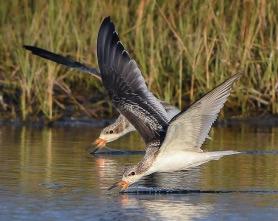
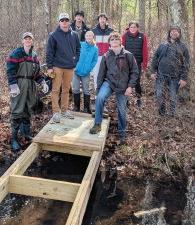
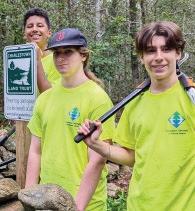


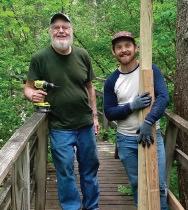
High school students from Moses Brown School have an opportunity to participate in an immersion program of their choice each year, spending four days engaged in something other than their regular classes. Audubon was fortunate to have a group from the “Utility of Nature” program propose and design a trail bridge on the Maxwell Mays Wildlife Refuge in Coventry. With oversight from Audubon staff, the students constructed the new bridge in April. Audubon sends a big thank you to the students and their instructors for their enthusiasm, hard work, and commitment to conservation.
Each summer, high school and college students from across the region team up and form the Youth Conservation League. Managed by Audubon, these dedicated youth gain valuable experience and contacts in the fields of conservation and land management. Starting in July, you may spot them out working on Audubon wildlife refuges or at other land trusts properties across the state.
Discover the art of nature observation guided by Audubon naturalists. Four hands-on classes provide the skills needed to communicate scientific information through art. Participants will gain new knowledge and explore a variety of natural habitats. Register for one program or all four: Aug. 9, Sept. 13, Oct. 1, Nov. 8, 2025. For locations and details, visit asri.org/calendar.
Peter Green
With stunning views of the Kickemuit River and salt marshes, sections of the trails close to the shore at Touisset Marsh Wildlife Refuge can get muddy. Audubon properties staff keep a close eye on the boardwalks, maintaining and replacing them when necessary, as shown here this spring. The refuge also has fields of flowers that attract butterflies in the warmer months, so head over to Warren and enjoy an easy and scenic stroll this summer.
Would you like to care for the Audubon trails and greenspaces you enjoy? Get outside and give Audubon a hand during volunteer crew days! Audubon volunteers cut and remove invasive plants, prune trailside trees, weed gardens, and so much more. Crew days are offered once a month, March through December, on several of Audubon properties. Join the team! For details visit asri.org/CrewDays
Habitat Restoration at Davis Memorial Wildlife Refuge
Rhode Island Energy (RIE) and Audubon are collaborating on bird and pollinator habitat restoration at the Davis Memorial Wildlife Refuge in North Kingstown and East Greenwich. The Revolution Wind Transmission Line Upgrade began in 2022 to carry electricity from new offshore wind, and many of the existing powerlines and towers had to be upgraded to handle the increase in electricity. Some habitat was disturbed during this construction phase.
The forestry department at RIE is managing the habitat restoration by improving soil, preventing erosion of exposed land, and planting native seeds, wildflowers, shrubs and trees. Audubon is overseeing the habitat work and will keep track of the recovery and use by pollinators, birds and other wildlife. Although much of the work is in areas with restricted access for safety reasons, some habitat will be visible from the trail at Davis. Look for a new sign highlighting the importance of pollinator habitat in the areas under the new wires.
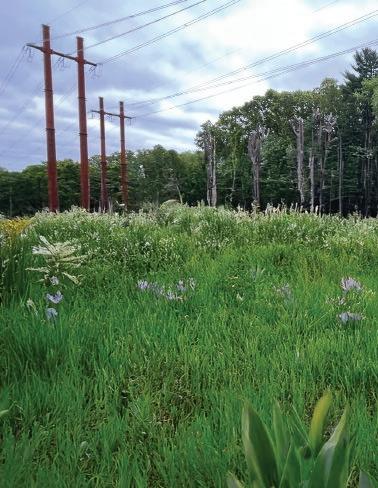

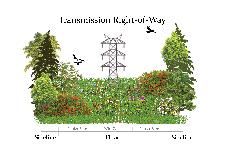


For more information and to register, visit the events calendar at asri.org/calendar.
Birding with Audubon
Advance registration is required for all programs.
Birding Banding
Two Dates Offered.
Audubon Nature Center and Aquarium, Bristol, RI. August 16, October 4, 2025; 8:00–10:00am.
Shorebird Van Trip
Locations across Rhode Island
Departs from Fisherville Brook Wildlife Refuge, Exeter, RI. August 27, 2025; 7:00am–3:00pm.
Wednesday Morning Bird Walks
Locations Across Rhode Island
Each week a new birding destination is chosen. Location will be sent to registered participants. Every Wednesday Sept. 2025–June 2026; 9:00–11:00am.
Fall Birding Adventure
Locations across Rhode Island
Departs from Fisherville Brook Wildlife Refuge, Exeter, RI. September 27, 2025; 8:00am–4:00pm.
Hawk Watch at Napatree Point
Napatree Point, Westerly, RI. September 27, 2025; 11:00am–1:00pm.
Birding Van Trips
See page 35 for details.
Free! Rain Harvest Festival
Roger Williams Park, Providence, RI. September 28, 2025; 11:00am–2:00pm.
Join a celebration of science, water and art with environmental activities, games, music, free food, and more! Visit www.stormwaterinnovation.org/RainHarvestFestival.
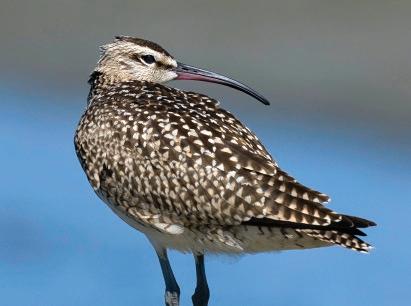
Audubon Nature Center and Aquarium
1401 Hope Street (Route 114), Bristol, RI
New England Flora and Fauna
Exhibit by the Photographic Society of Rhode Island.
July 6 through August 31, 2025; 9:30am–4:30pm.
Yoga at Audubon
July 20, Aug. 24, Sept. 28, Oct. 26, Nov. 23, 2025; 9:00–10:00am.
Saving the Diamondback Terrapin
Film Screening and Q&A.
July 29; 2025; 6:00–7:30pm
Designing a Wildlife Garden Workshop
Two Dates Offered.
August 9, 2025; 1:00–2:30pm. October 18, 2025; 10:00–11:30 am.
Edible & Medicinal Plant Walk
Two Dates Offered.
August 16, 2025; 3:00–5:00pm.
September 25, 2025; 5:00–7:00pm.
Watercolor Exhibit by Arianne Del Rios
September 1–October 31, 2025; 9:30am–4:30pm.
Birds and Brews
September 5, 2025; 6:00–8:30pm.
Native Seed Saving and Winter Sowing
September 13, 2025; 2:00–3:00pm.
Native Plants and Pollinators Lecture
November 22, 2025; 10:00–11:00am.
New! Summer Nature Series for Families and Children
Birds, Bugs, Frogs and Fun!
Check out the weekly schedule at asri.org/calendar.
Birding Banding with Audubon
Two Dates Offered.
August 16, October 4, 2025; 8:00–10:00am.
Raptor Weekend
September 6 & 7, 2025; 10:00am–4:00pm.
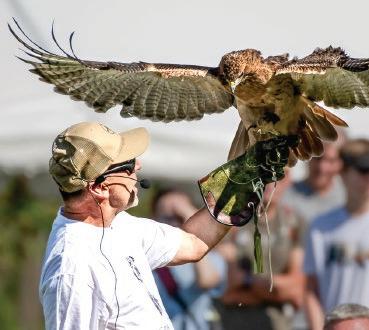
Visit the Nature Center and Aquarium with fewer guests, a quieter environment, and no screens. For dates and details, visit asri.org/SensoryFriendlyHours Sensory Friendly Hours
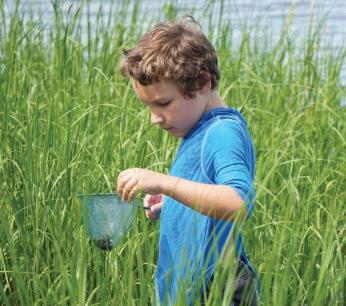
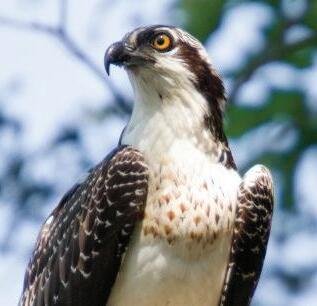
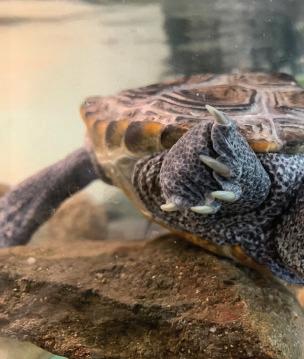
Caratunk Wildlife Refuge
301 Brown Avenue, Seekonk, MA
Nature Journaling: Natural Habitats
August 9, 2025; 10:00–11:30am.
Owls and Ales
October 17, 2025; 6:30–8:30pm.
Bones and Brews
October 24, 2025; 6:30–8:30 pm.
Big Raptor, Little Raptor
November 15, 2025; 11:00am–12:00pm.
Fisherville Brook Wildlife Refuge
99 Pardon Joslin Road, Exeter, RI
Taking the Mystery out of Mushrooming
August 23, 2025; 10:00am–2:00pm.
Beavers of Fisherville
November 4, 2025; 4:30–6:30pm.
Owls and Ales at Fisherville
November 14, 2025; 6:30 pm–8:30pm.
Owl Prowls
Locations across Rhode Island
Owl Prowl on the Harvest Supermoon Powder Mill Ledges Wildlife Refuge, Smithfield, RI. October 6, 2025; 6:30–8:30pm.
Full Moon Owl Prowl at Fort Two Dates Offered Fort Wildlife Refuge, North Smithfield, RI. October 7, November 5, 2025; 6:30–8:30pm.
Owls and Ales
Caratunk Wildlife Refuge, Seekonk, MA October 17, 2025; 6:30–8:30pm.
Beaver Moon Owl Prowl
Powder Mill Ledges Wildlife Refuge, Smithfield, RI. November 6, 2025; 6:30–8:30pm.
Owl Prowl at Ruecker
Emilie Ruecker Wildlife Refuge, Tiverton, RI. November 7, 2025; 6:30–7:30pm.
Owls and Ales at Fisherville
Fisherville Brook Wildlife Refuge, Exeter, RI. November 14, 2025; 6:30 pm–8:30pm.
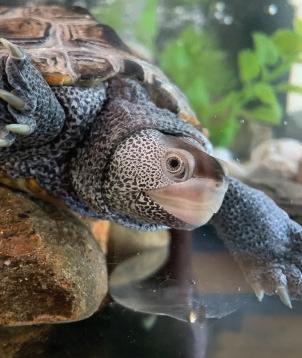
Maxwell Mays Art Studio
Maxwell Mays Wildlife Refuge, 2082 Victory Highway, Coventry, RI
Intermediate Watercolor
Three Dates Offered.
Aug. 12, Sept. 16 and Oct. 14, 2025; 1:30–4:30pm.
Wednesday Walk and Watercolor
Aug. 13, 27; Sept. 3, 10, 17; Oct. 1, 8, 15; 9:30am–1:00pm.
Thursday Evening Watercolor
Three Dates Offered.
Aug. 14, Sept. 11, Oct. 9, 2025; 6:00–8:30 pm.
Fridays: The Fresh Palette
Monthly Watercolor Painting Nights.
Aug. 29, Sept. 19, Oct. 24, 2025; 6:00–8:30 pm.
Sea Glass and Porcelain Wrapping
Two Dates Offered.
Sept. 5, Oct. 17, 2025; 6:00–8:00pm.
Nature Journaling: Mushrooms
September 13, 2025; 10:00–11:30am.
Powder Mill Ledges
Wildlife Refuge
12 Sanderson Road, Smithfield, RI
Leaf Print Tote Bags
August 2, 2025; 10:00am–12:00pm.
Owl Prowl on the Harvest Supermoon
October 6, 2025; 6:30–8:30pm.
Beaver Moon Owl Prowl
November 6, 2025; 6:30–8:30pm.
Knit Owls
November 18, 2025; 5:30–7:00pm.
Prudence Island
Narragansett Bay National Estuarine Research Reserve, Prudence Island, RI
Mushrooms for Beginners
September 25, 2025; 1:30–6:30pm.
Fall Hiking on Prudence Island
October 24, 2025; 9:45am–4:45pm.
Explore Prudence Island
November 5, 2025; 9:45 am–4:45 pm.
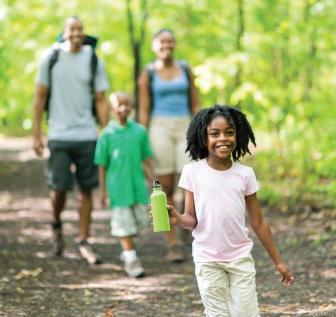
Nature Walks
Touisset Full Moon Hike
Touisset Marsh Wildlife Refuge, Warren, RI August 8, 2025; 8:00–9:30 pm.
Geology of Rhode Island – Cliff Walk
Cliff Walk, Newport, RI October 18, 2025; 11:00am–12:30 pm.
Nature Journaling Workshops
Nature Journaling: Natural Habitats
Caratunk Wildlife Refuge, Seekonk, MA August 9, 2025; 10:00–11:30am.
Nature Journaling: Mushrooms
Maxwell Mays Wildlife Refuge, Coventry, RI September 13, 2025; 10:00–11:30am.
Nature Journaling: Trees
Touisset Marsh Wildlife Refuge, Warren, RI October 11, 2025; 10:00–11:30am.
Nature Journaling: Successional Field Walk
Frances Carter Preserve, Charlestown, RI November 8, 2025; 10:00–11:30am.
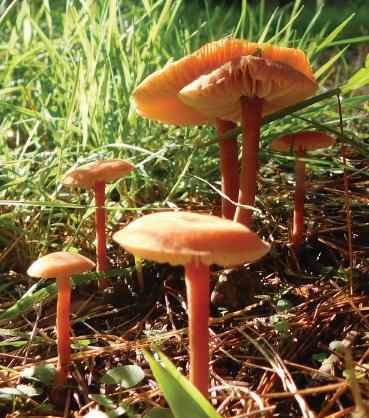
Audubon Field Naturalist Series
Indulge your curiosity and delve into the complexities of the natural world. Six sessions, from August through October, explore ecosystems, insects, mammals, fungi and more. See page 39 for details or visit asri.org/calendar.


By Lauren Parmelee, Senior Director
If you hear a drumming sound coming from trees in your neighborhood, look for a woodpecker. You might be able to spot one of the six species that call Rhode Island home. These birds bang their beaks against trees on an average of 12,000 times per day!
Some birds sing in the spring to establish their territory and attract a mate. Woodpeckers drum instead. They try to find just the right place on a wooden or metal object or structure where their drumming resonates the loudest. Sometimes that place might be your house!
In addition to their drumming skills, woodpeckers make all kinds of calls to communicate. You can listen to their different noises at allaboutbirds.org
These amazing birds use their strong pointed beaks to tap holes in trees and then stick their long tongues in to gather insects like beetle larva. When not in use, their long tongue rests in the space under their skull, helping to cushion the brain from the impact of their tapping.
Woodpeckers have two toes in front and two toes in back that enable them to climb and hang onto the tree bark. Their stiff tail feathers help prop them up as they tap.
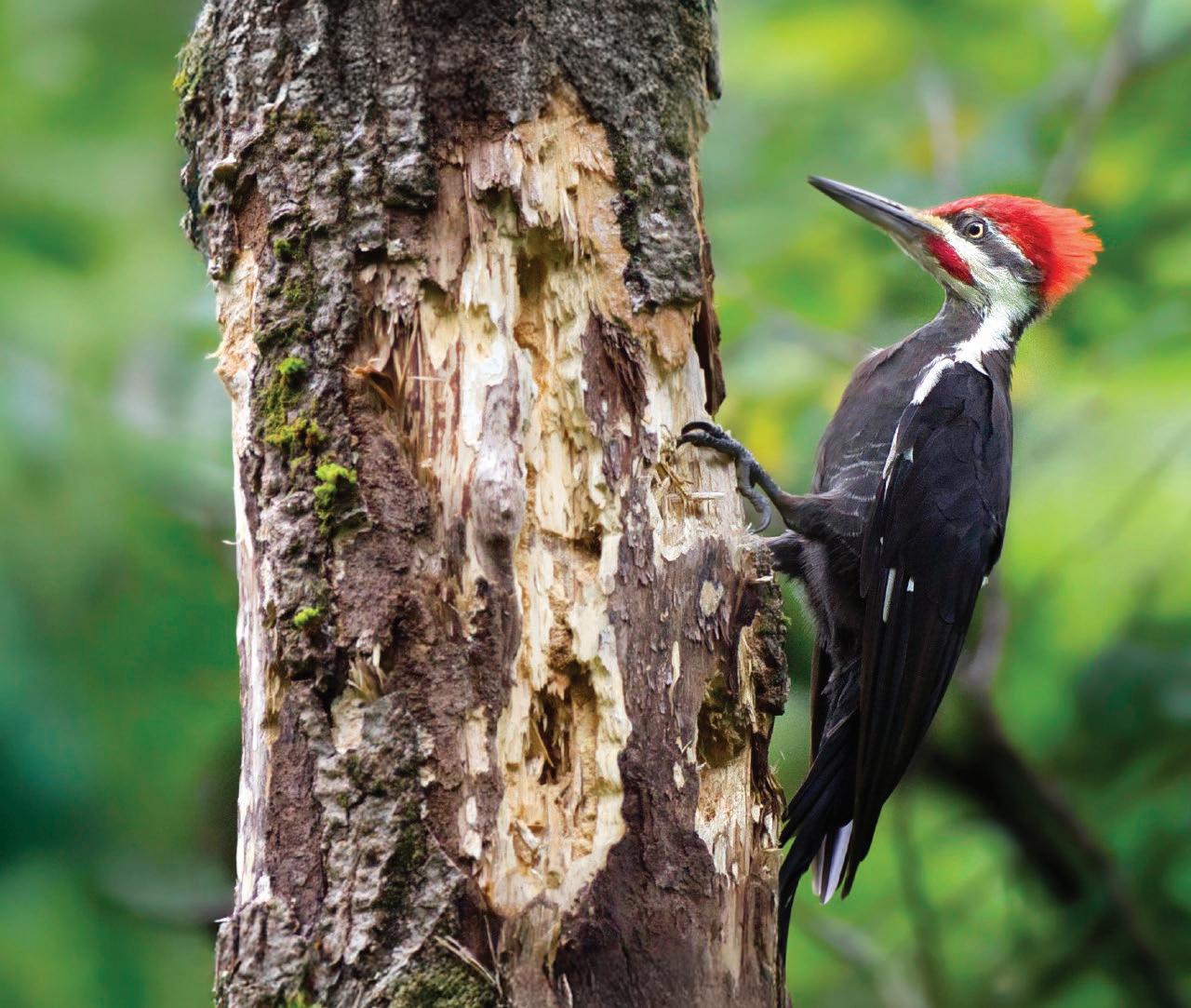

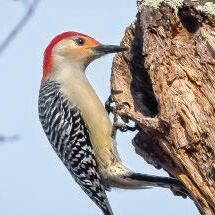
Northern Flickers often feed on the ground looking for ants and beetles. If you happen to scare them and they fly up, look for their big white rump patch and yellowshafted underwings.
Red-bellied Woodpeckers have fine black and white barring on their backs, but the reddish on the belly is usually hard to see. Their tongue can stick out two inches from the end of their beak!
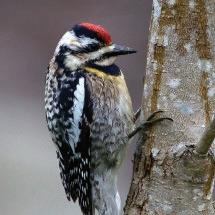
Yellow-bellied Sapsuckers drill lines of tiny holes in the bark called sapwells. Their brushtipped tongue helps them gather the sweet liquid for a meal. Hummingbirds and insects are also attracted to the oozing sap.
Woodpeckers create their own nest cavities in old trees by using their tapping skills. You can tell if the Pileated Woodpecker has made a nest hole because it will be rectangular rather than round. This large woodpecker has a fancy red crest atop its head.
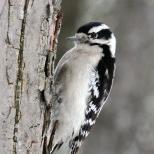
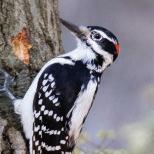
Downy Woodpeckers are the smallest and most common woodpecker in our area. They are black and white, and often visit bird feeders. They are hard to tell apart from the larger Hairy Woodpeckers at first, but if you pay close attention, the Hairy Woodpecker is larger with a longer beak.
DON’T MISS THIS!
Concert for Conservation
July 23, 2025; 4:00pm Ragged Island Brewery
Bring family and friends to Ragged Island Brewery in Portsmouth and enjoy a cold ale, listen to live music, and support Audubon’s conservation initiatives.
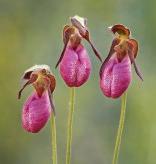

CHECK IT OUT!
New England Flora and Fauna:
Exhibit by the Photographic Society of Rhode Island
Through August 2025
Audubon Nature Center and Aquarium, Bristol, RI
Stop in this summer and experience stunning images taken by members of the Photographic Society of Rhode Island. The group strives to promote photography as an art form and provide a supportive community for photographers of all skill levels.
Photo of Lady Slippers by Dennis Goulet
BRING THE KIDS Member Movie Night in Bristol
August 9, 2025
Audubon Nature Center and Aquarium, Bristol, RI

Stay up late for an evening under the stars at the Nature Center and Aquarium! Bring a blanket or folding chairs and join other Audubon members for a special outdoor movie night. Yummy snacks and refreshments will be served. Watch for details!
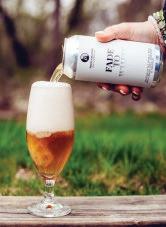
Birds and Brews
September 5, 2025; 5:30–8:30pm
Grab a cold brew and kickoff Raptor Weekend! Audubon partners with Proclamation Ale Co. for an evening of live music by the To Be Continued Band, locally brewed beer, and Audubon’s birds of prey. For ages 21+.
Tickets must be purchased in advance at asri.org/raptorweekend.
Raptor Weekend
September 6 & 7, 2025; 10:00am–4:00pm
Audubon Nature Center and Aquarium, Bristol, RI
Get up-close with owls, hawks, and falcons at Audubon’s annual celebration of birds of prey.
Advance tickets on sale July 24, 2025 at asri.org/raptor-weekend
Tickets may also be purchased at the event.
Yoga at Audubon
July 20, Aug. 24, Sept. 28, Oct. 26; 9:00–10:00am
Audubon Nature Center and Aquarium, Bristol, RI
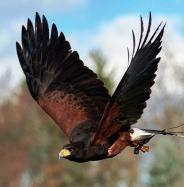

Experience the benefits of yoga while connecting with community and nature. Designed for all levels and abilities, classes are led by certified instructor Joanne Decataldo. Register at asri.org/calendar.

NEW! SUMMER NATURE SERIES FOR FAMILIES AND CHILDREN irds, Bugs, Frogs and Fun!
Learn fun facts in a close-up interview with owls, turtles, seahorses, and skates. Get creative and crafty. Search for butterflies in the pollinator garden or look for frogs in the wetlands. Try your hand at science experiments, and so much more!
heck out the weekly schedule at asri.org/calendar.
HAVE A WILD TIME! Birthdays at Audubon
What’s better than cool critters at a birthday party?
Audubon offers birthday parties for children at four wildlife refuges. Invite an owl, turtle or snake to join the fun!
Plan a celebration at asri.org/birthday-parties.
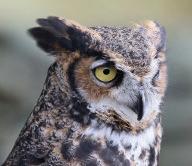

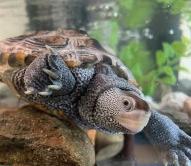
By Dr. Scott Ruhren, Senior Director of Conservation
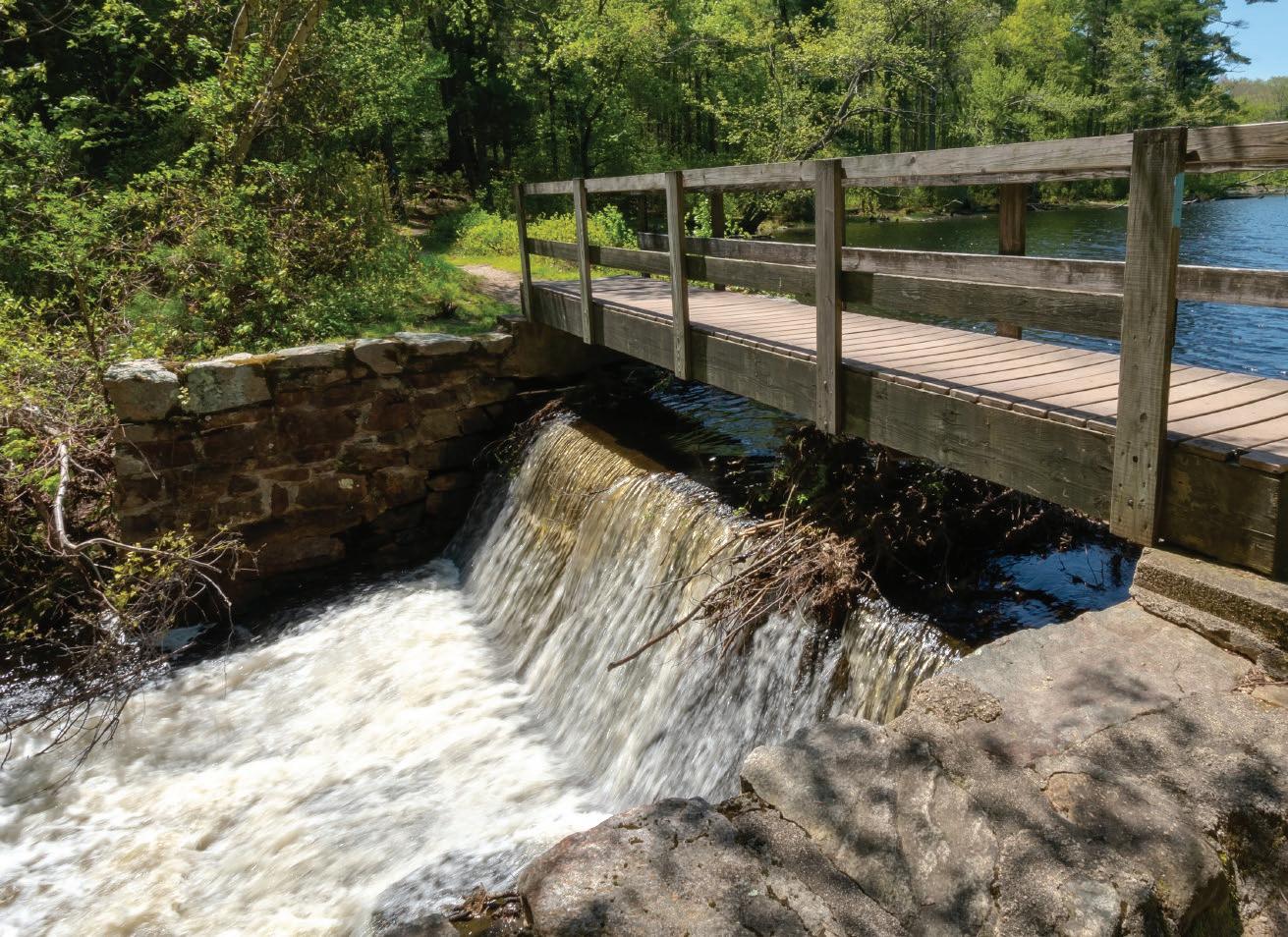
Fisherville Brook Wildlife Refuge
Dam and Waterfall at Fisherville Pond
People have been damming streams and rivers in New England for over 300 years to create reservoirs for drinking water, to run mills that grind grain and tobacco, and generate electricity. Dams are controversial and occasionally have broad impacts on ecosystems and the ancient cycles of the rivers.
Juvenile, tiny, and rare freshwater mussels travel up rivers on the gills of brook trout. This is the best way to colonize new stretches of rivers, if the fish have clear passage. With over 140 known dams in Rhode Island, that is not always the case. One of the main reasons that Atlantic salmon no longer spawn in New England are dammed rivers.
Some dams are being removed intentionally and with scientific guidance. Audubon’s Touisset Marsh Wildlife Refuge in Warren lies along the Kickemuit River, a tidal estuary that flows south into Narragansett Bay. A couple of miles north of Touisset Marsh, two 19th and 20th century dams on the river were removed as they were no longer necessary for the town’s water supply. Although some neighbors were concerned about the resulting changes in water flow, the land is not flooding downstream from the former dam. Its removal has created new wetland habitats and allowed more free movement of fish. In fact, removing the dams has created hundreds of acres of habitat. River herring should now be able to travel further upstream than they have in over 100 years. Great Blue Heron, Great and Snowy Egrets hunt in the newly created mudflats in the former pond and
wetland plants have naturally colonized the exposed mud as the water receded.
Yet, many of the old dams do provide environmental benefits, often creating habitat that is vital to wildlife. There are several small dams that have outlived their original purpose on Audubon properties, including Davis Memorial, Maxwell Mays, and Fisherville Brook Wildlife Refuges. These dams have been evaluated and left intact as like many others in Rhode Island, they are responsible for creating healthy, functioning wetlands in the ponds above them. River herring and other migratory species also do not use the streams and rivers that are involved.
Beaver, nature’s ecosystem engineers, are famous for the dams they occasionally build to create ponds, to keep them safe from predators, and to help move the branches they need for food and shelter. When beaver create dams, their actions also bring productive wetlands used by many birds including Belted Kingfisher, Red-winged Blackbird, Northern Waterthrush and Barred Owl as well as Wood Duck and Hooded Merganser. Fish, mollusks, amphibians, reptiles and many insects also benefit. The dams help trap sediments carried
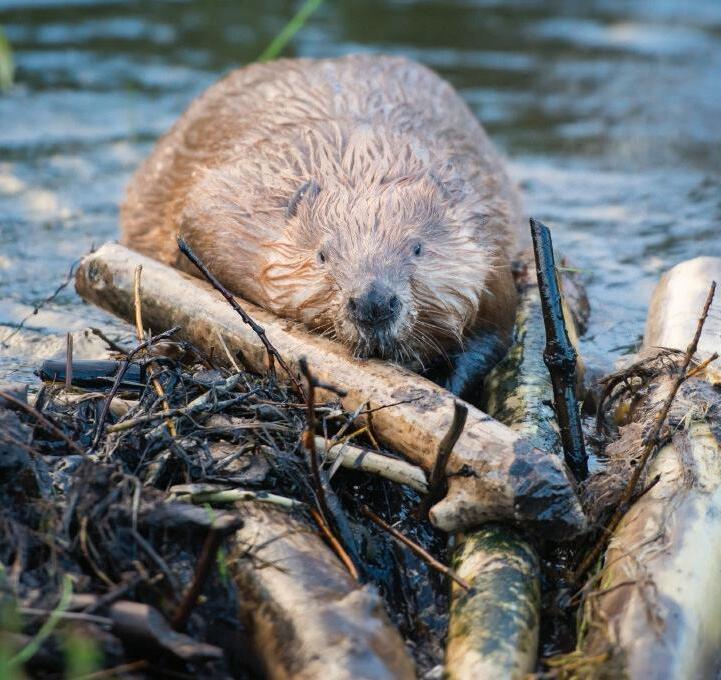

Fisherville Brook Wildlife Refuge Beaver Dam Under Trail Bridge
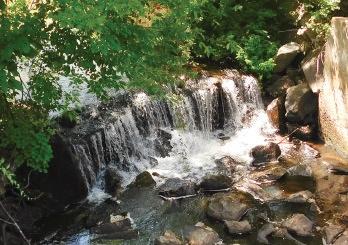
for the complete list and to donate. Donate Today and Support Audubon!
• Sponsor Monthly Free Family Fun Day
Provide free admission to the Nature Center and Aquarium. $1,000/day
• Trail Cams
Help Audubon monitor parking lots and gather data on visitation. $150/camera
• Litter Pickup Gear
Gloves, poison ivy wipes, grabbers, and trash bags are needed. $600
• Fund Crafts for Kids
Support craft materials for kids at the Nature Center and Aquarium. $300/month
• New Septic System for Caratunk Wildlife Refuge
Donate and support one of Audubon’s most popular refuges. $35,000
• Lumber for Bog Bridges
Fund much needed bridge replacements and repairs. $5,000
• Sponsor a Bus
Transport a school group to an outdoor field trip. $400/bus
• Raffle and Silent Auction Items
Support Audubon fundraisers. Donate gift certificates, a vacation rental, or event tickets.
by storm water and provide places for the roots of countless wetland plants. Beaver and their work can be seen at Audubon’s Fort, Fisherville Brook, and Maxwell Mays Wildlife Refuges as well as in many wetlands where these mammals live. As with human dams, beaver dams alter the ecosystem, but their dams are often temporary as they collapse when beaver move to other locations.
While Audubon staff was recently on a quest to locate a remote vernal pool in the West Greenwich section of Fisherville Brook Wildlife Refuge, a surprise was found. As this sensitive habitat was measured and evaluated, it was noted that the pool was manufactured, created by a low, very old concrete dam that was slowing the flow of water out of the area. The original purpose for this dam was difficult to decipher. Years of weather and lack of any human maintenance had worn away other artifacts or hints to its origin. It could have been a watering hole for livestock at one time, but the years had filled much of the pond with soil and plants as the forest closed in around it.
While ecosystems benefit from letting streams and rivers flow naturally and Audubon supports the careful reopening of rivers to restore their ancient function and courses, any dam removal should be carefully evaluated with scientific guidance. To be the best stewards of wildlife habitat, Audubon continues to evaluate the status of our dams and the roles they will play in the future.
• Nature’s Calling
Donate to keep the portalets on the wildlife refuges clean. $500/monthly cleaning of all portalets.
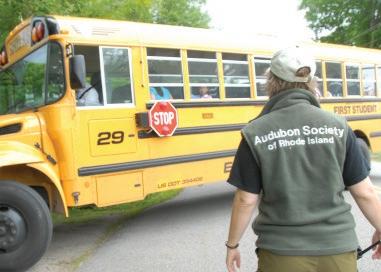
Thank you for your support!
Continued from page 7
explains, “we had to take action and met with Jamestown residents, representatives of the Jamestown Conservation Commission, and Charles [Clarkson] has spoken to a group of concerned individuals.” A letter went out to RAB expressing their opposition, and Audubon has had conversations with RIDEM expressing concern over opening the island. Full-page ads have appeared in The Jamestown Press and Newport This Week, and Hall co-authored an opinion piece with Audubon Board President David Caldwell, Jr. that was published in the Jamestown Press in May. Along with the Jamestown Conservation Commission, Save The Bay is also among community partners rallying against the proposed change.
All these efforts are serving the primary purpose of encouraging further dialogue, and showing the proposal’s supporters, who otherwise may not know, what’s really at stake. Hall explains, “Our immediate goal is to communicate with the people of Jamestown to see if they are willing to pull their resolution. We will then go to all the other communities that have supported opening Gould Island to recreation and try to convince those towns and cities to pull back their resolutions. Audubon also continues to work with RIDEM to discourage this change.”
“We want the State to understand that their own biologists have identified Gould Island as an important nesting area that needs to be conserved,” he continues. “Audubon has the science and research backing us on this issue. Over the last three years, we have put a significant amount of resources into the science behind our advocacy. We are able to make strong, informed arguments on why this island needs permanent protection.
As the RIDEM explores the possibility of removing the wildlife sanctuary deed restriction on Gould Island, it’s difficult to ignore the contradictions in even considering a move that would almost certainly be detrimental to species of colonial breeding waterbirds that, by their own research and data, are in greatest need of conservation.
“Removing a deed restriction that establishes a wildlife sanctuary now, during a time when we’re seeing biodiversity loss to such a great degree, is really setting a dangerous precedent,” says Clarkson. “We need to view ourselves as stewards of these wildlife resources and act in their best interest.”
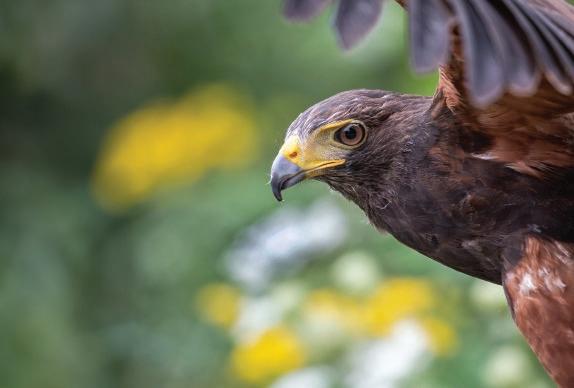
It’s no accident that these gulls, herons, and cormorants return every year. Their persistent pilgrimage to Gould Island is largely due to the absence of other islands providing the same unique advantages, as other options, like Rose Island, have been removed from the equation.
Audubon Board Member Carol Lynn Trocki served on the Rose Island Lighthouse Foundation board a number of years ago. A conservation biologist and advocate for making outdoor spaces accessible, Trocki witnessed firsthand the departure of colonial nesting waterbirds from Rose Island and understands the balancing act between existing in wild spaces and letting others simply be left alone.
September 6 & 7, 2025
10:00am–4:00pm
Audubon Nature Center and Aquarium, Bristol, RI. Live presentations with Owls, Hawks and Falcons!
Purchase tickets online at asri.org/raptor-weekend
There are so few places left, in Rhode Island especially, that can be used by these sensitive species of birds that are declining elsewhere. I think it's very irresponsible to consider shifting that balance in favor of human use when it puts wildlife use at risk.
– Carol
“ “
She recalls the formation of the Foundation decades ago, which effectively protected the lighthouse and preserved Rose Island from development. In 1999, she says, “the bulk of the island was covered by a conservation easement meant to protect the nesting bird colony and the wildlife refuge, which included restrictions that a significant portion of the island not be publicly accessible during the nesting season from April to August.”
Though the parcel was rescued from becoming home to a marina and condominiums, an increase in human activity over time, all conducted within the regulatory permissions in place on the island,
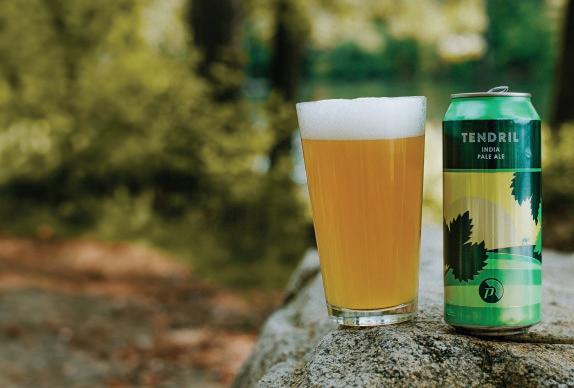
September 5, 2025; 5:30–8:30pm
Sip cold local brews and get up close with some cool birds! Audubon partners with Proclamation Ale for a night of beer, music and birds of prey.
Purchase tickets early! Visit asri.org/raptor-weekend

thinned the bird populations once abundant there, despite efforts to keep people away from the designated nesting grounds. “There was a big push to keep expanding the human footprint on the island, and in doing so, I feel like it, very much unintentionally, went past the point of what these sensitive wildlife species were willing to tolerate,” says Trocki.
“I think it’s a very similar story, which is why it proves instructive,” she continues. “My understanding of the proposal for Gould Island is that it is also motivated by a desire to provide recreational access to a coastal area that is otherwise undeveloped.” And though well-meaning, the very logical, human process of drawing lines and creating boundaries in which birds and people can theoretically coexist, is lost in translation for these scrupulous species whose tolerance for us is not what some might wish.
“There are so few places left, in Rhode Island especially, that can be used by these sensitive species of birds that are declining elsewhere. I think it's very irresponsible to consider shifting that balance in favor of human use when it puts wildlife use at risk.”
Audubon’s fight for Gould Island’s protection is only just beginning. On a sweeping scale, notes Clarkson, “Organizations are having a lot of difficulty with regards to funding environmental restoration and protection projects, which means conservation is needed now more than ever.” Hall echoes this sentiment, noting the threat to open space protection and budget cuts as a challenge to these efforts nationwide.
“Getting the message out there, and educating the public, the concerned citizens of Rhode Island, about the plight of these birds is one

of the most important things we can do as a conservation organization right now,” Clarkson says.
Though the proposal has gained a lot of traction, its opposition tends to be optimistic that spreading awareness about what’s at stake will shift the tides. Already, a petition to protect the island has garnered over 500 signatures, and Audubon continues to bolster their awareness campaign in the form of letters to the editor in local papers and by showing up to meetings.
One island remaining closed to camping is, arguably, a small sacrifice to ensure many years to come of successful nesting for species vulnerable to a changing landscape, as well as the enrichment their presence brings to all of the spaces to which we already have access.
“It's hard for me to imagine living in a coastal state and visiting coastal wetlands and not having these birds present,” says Trocki. “What if we didn't have herons and egrets here in the summertime feeding in our salt marshes? What if we went to the beach and didn’t have terns flying over, fishing offshore, or gulls crying in the area? It wouldn't be the same place.”
The bleak future Trocki describes is thankfully preventable. The case of colonial nesting waterbirds on Gould Island is an opportunity to show how land stewardship can be done well, even if it means walking back an idea that’s appealing at first glance in favor of a future that has many more generations of birds convening in wild and shared spaces, and humans who appreciate them.
Abbie Lahmers is a communications specialist for both the Metcalf Institute at the University of Rhode Island and Roger Williams Park Conservancy, as well as a freelance writer who enjoys hiking, camping, and birding around New England. She can be reached at amlahmers@gmail.com.

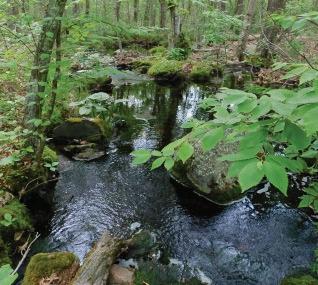

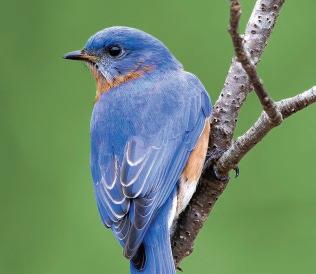
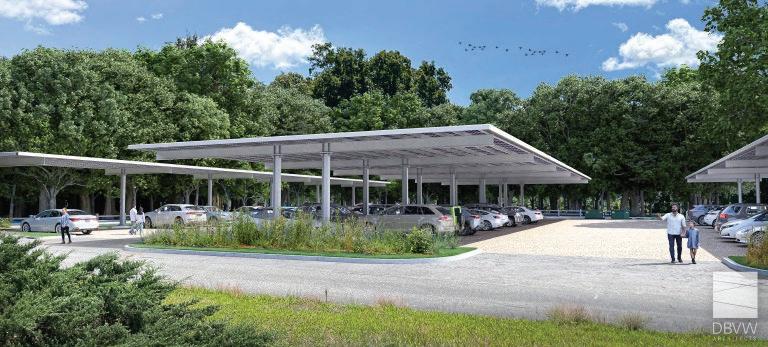

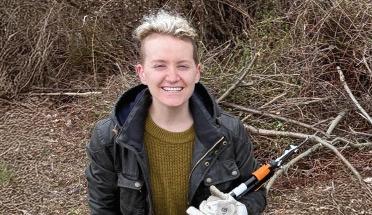
Pip Zawatsky
Conservation Volunteer
Pip Zawatsky (they/them) has been involved in several Audubon volunteer opportunities over the past year. From helping Audubon conservation staff remove invasive autumn olive from fields at Caratunk to assisting with a community science initiative to monitor vernal pools, their passion for science has been put to good use. Audubon thanks Pip for their ongoing help and commitment to conservation.
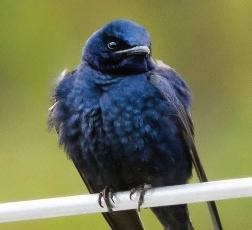
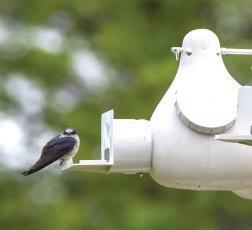
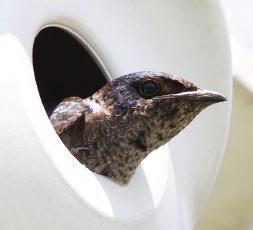

Corporate Volunteers at Powder Mill Ledges
Volunteers from Bank of America joined Audubon in May for a day of conservation work in Smithfield, RI. They got right to work with trail maintenance, trash pickup, plantings in the pollinator garden, mowing, and more. Audubon is grateful to have a strong base of volunteers. Thank you to the Bank of America team for a job well done.
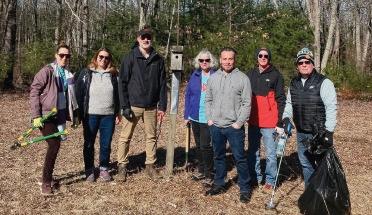
Supporting Cavity Nesting Birds
Acrew of volunteers from AAA Northeast bundled up and joined conservation staff in March to clean out nesting boxes on Audubon properties in Smithfield, RI. Preparing the boxes for breeding season is always a big chore. AAA volunteers also worked over the winter to build new nesting boxes and Audubon is grateful for their ongoing support of bird conservation.


They are hard to miss, those tall frames in the field with dangling white gourds. They resemble apartment houses for birds and are designed to lure Purple Martins, who nest together in colonies during the summer.
Even though their field habitat is in decline, Purple Martins can be picky about selecting a home. Gourds were installed eight years ago at Fisherville Brook Wildlife Refuge. After three years of patiently waiting, a young male was spotted singing to find a mate. Two years later he attracted a female, and the couple have raised five chicks each year since. Now they have neighbors! A second pair of Purple Martins has been observed going in and out of a gourd, and a third pair is investigating the site. This is welcome news for this species in decline. These arial insectivores prefer open field habitat, away from large trees as they need plenty of space to hunt flies, butterflies, and dragonflies. Listen for their chatter at Fisherville Brook and watch their acrobatics over the field near the historic cemetery.
Audubon maintains and protects over 200 acres of field habitat across Rhode Island to support these and other species.
The companies listed below have demonstrated their significant commitment to the quality of life in Rhode Island and to conserving natural habitats through stewardship and education.
Bank of America, Botanica Land Care, Caldwell Realty Rhode Island, JDRE Homes, NEC Solar, NOW 93.3, NRCS, Prickly Ed’s Cactus Patch, RI PBS, Sunflower Designs, Tupelo Design Studio, Woodscapes, Inc.
The people listed below have been honored by family and friends who found a gift to the Audubon Society of Rhode Island to be the most meaningful way to celebrate someone important in their lives.
Nelson Brinckerhoff from Marilyn Kellogg Beatrice Robinson from Karen Del Ponte
Memorials serve and support the conservation and protection of Rhode Island’s environment. The families and friends of people listed below have chosen to remember their loved ones through a gift to the Audubon Society of Rhode Island.
Jack Doherty from Judith Doherty
William Folsom from Judith Folsom
Bill Harsch from Dutch Island Lighthouse Society
Lynne Lehman from Elizabeth Glazer, Joan McCall
Bruce McCarthy from Mike Kennally, Antonia McGuire, The Encore Shop
Richard Nagle from Jill Vitko
Sara (Sally) Panciera from Sandra Barkley
Dominick Zoccoli from Don Heitzmann, John Matthews, Susan Peterson


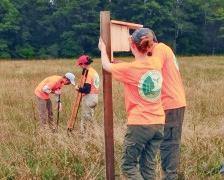

June Rockwell Levy Foundation Awards $15,000 to Support Environmental Education
The June Levy Rockwell Foundation recently provided $15,000 to support Audubon’s environmental education initiatives. This generous funding will allow Audubon educators to provide hands-on learning experiences in the field and classroom to Rhode Island students in every school district across the state.
Audubon Receives Generous Funding from Mary Ann Cofrin to Support the Youth Conservation League, Avian Research, and the Environmental Education for Urban Schools Initiative.
Audubon is grateful for a generous gift from Mary Ann Cofrin that will be used across three critical initiatives in 2025. New members of the Youth Conservation League will hold paid positions and gain valuable experience in environmental conservation this summer, Audubon educators will reach more youth with hands-on science programming in city communities, and vital research will continue to expand in the Audubon Avian Research Initiative.
Funding of $5,000 Received from the John E. Fogarty Foundation to Support Urban Education
Funding from the John E. Fogarty Foundation will assist Audubon educators as they reach Rhode Island students in kindergarten through high school with hands-on science experiences. The Audubon Environmental Education for Urban Schools Initiative focuses on students living in the cities of Providence, Pawtucket, Central Falls, and Woonsocket.


Bloom Rhode Island Awards Audubon $500 to Support Pollinator Gardens
Bloom Rhode Island is a not-for-profit initiative supporting Rhode Islanders who bring joy to public spaces with plants and flowers. Audubon thanks the organization for their donation to support pollinators and the native plants they need to thrive.
Do you have an Audubon education program, research initiative, or conservation project that has special meaning to you? Our wish list is full of needed items, both big and small, that would support our work.
To choose one item, or support an entire initiative, visit asri.org/wishlist. Thank you for your support!
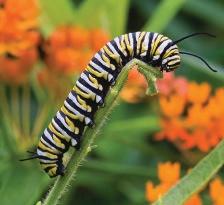
The Green Century Fund Provides $1,000 in Funding to Support Audubon’s Transforming the Landscape Symposium
The Green Century Fund provides ways for people to align their investments with their values by keeping their money out of the most irresponsible industries. Audubon is grateful for their support of the Transforming the Landscape Symposium, which educates community members on environmentally-sound practices to protect pollinators, birds, and other wildlife.
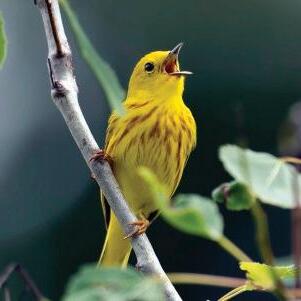

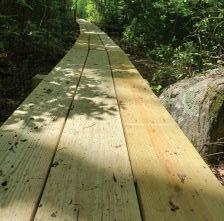
Audubon Receives $6,000 from the Kimball Johnstone Foundation to support the Avian Research Initiative
udubon thanks the Kimball Johnstone Foundation for their support of the Avian Research Initiative that monitors the abundance and distribution of birds and insects on Audubon wildlife refuges with the goal to enhance long-term biodiversity.
Over $905,000 has been raised to date by generous donors to support Audubon’s transition to a clean energy future. Audubon is grateful for each gift from members, supporters, organizations, corporations, and grants that are helping us to reach our long term sustainability goals.
Generous Supporter Funds New Wetland Boardwalk at Fisherville
Thanks to funding from an anonymous donor, visitors to Fisherville Brook Wildlife Refuge in Exeter will have drier boots this summer. Construction on a new, 100-foot wetland boardwalk was begun by properties staff in June, replacing smaller disconnected footbridges that were mismatched and unstable.
Everett Stuart Receives 2025 Peter Merritt Award
For over 40 years, Ev Stuart has supported Audubon. From his volunteer days mowing fields to serving on the Audubon Board of Directors and the Council of Advisors, Stuart is the definition of a dedicated conservationist. He recently received the Peter Merritt Award for Land Conservation from the RI Land Trust Council, recognizing a volunteer who has made an outstanding contribution to land conservation in their Rhode Island community. Audubon thanks Stuart for his years of service and congratulates him on receiving this distinguished award.
AUDUBON NATURE CENTER & AQUARIUM
Ideal for weddings, showers, or the site of your next business meeting or off-site retreat. Located in historic Bristol, RI, just 30 minutes from Providence, Newport, and Fall River, the award-winning Audubon Nature Center and Aquarium is one of Rhode Island’s unique meeting venues. With beautiful trails, exhibits and aquarium, large meeting, reception, and outdoor patio space, the Nature Center provides a setting that will captivate guests.
For availability and reservations, visit asri.org and click on services or contact Events Coordinator Sarah Bradley at 401-949-5454 x3016 or sbradley@asri.org.
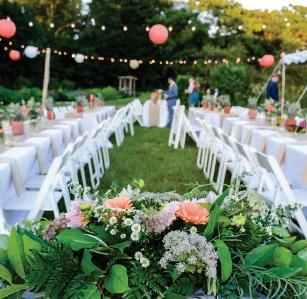
The big white barn at Caratunk provides the perfect rural setting for weddings, showers, family reunions, business meetings, or birthday parties for children.
For availability and reservations regarding weddings and birthdays, visit asri.org and click on ‘services.’ For all other rental queries, contact Michelle Solis at msolis@asri.org.
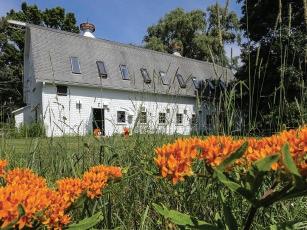


From its founding in 2020, a key component of the Stormwater Innovation Center’s mission has been to improve water quality through education and outreach.
By Rebecca Reeves, Stormwater Education and Outreach Manager
Stormwater Innovation Center (SIC) staff and collaborating organizations envisioned a three-phase project to introduce basic stormwater concepts to the public. As so many of the green infrastructure components blend in seamlessly with nature, the goal was to highlight these projects located throughout Roger Williams Park - sometimes referred to as the People’s Park of Providence.
That’s where José Menéndez, Assistant Professor of Graphic Design and Architecture at Northeastern University and co-owner of the socially minded graphic design company Buena Gráfica Social Studio, became involved. In addition to his strong design experience, Menéndez formerly trained and worked as a landscape architect and holds a master’s degree in marine affairs, so he had a particular interest in the intersection of science and community outreach. Due to his academic experience, he approached this project with an eye toward research and scholarship, as well as accessibility and community partnership.
The first stage of the project was to create a semi-permanent installation of large, educational signage boards along the fence close to the Seal House - a popular site near the park’s Japanese Garden and Carousel. These large signage boards, which are presented in both English and Spanish, are designed with a glossary first, so that common terms become familiar, and the content is easier to follow. Pictures and text then guide readers through a stormwater journey, from precipitation to storm drain to final discharge into water bodies like the Pawtuxet River and Narragansett Bay.
The graphics feature local landmarks, like the Superman Building in Providence and the Pawtuxet Village bridge, to ground readers to a sense of place. These graphics demonstrate how stormwater impacts both smaller environments, like the park and its surrounding neighborhoods, and larger areas, like forests, bays, and the ocean.
They are bilingual and inclusively designed. For example, houses rendered on the boards represent both homeowners and renters. “Our goal with this project was to make stormwater science approachable and relevant to everyday life,” explained SIC Stormwa-
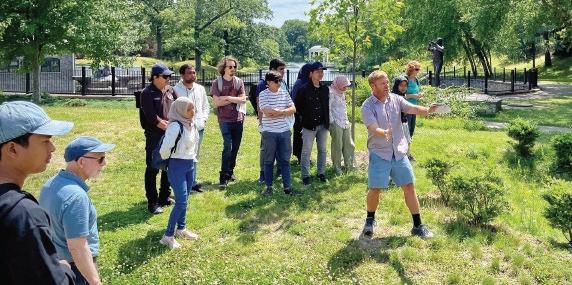
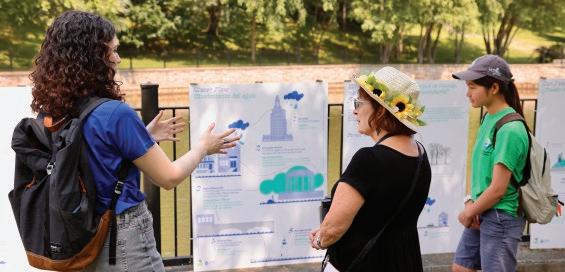
ter Director Ryan Kopp. “By showing how runoff from our homes and streets affects local ponds, rivers, and even the bay, we hope to inspire people to take simple steps at home to protect water quality. These materials also raise awareness about the growing threat of toxic cyanobacteria blooms, not just as an environmental issue, but as a public health concern that affects the entire community.”
Hundreds of students, from children in elementary grades up to those completing college coursework, have started studying stormwater at the signage boards during educational field trips, which then led into close-up views of the park’s green infrastructure projects. Portable, lightweight versions of the boards were also printed for travel to schools or events, such as the SIC’s annual Rain Harvest Festival. The graphics have also been utilized for adult education - at networking events like the Stormwater Innovation Expo, as well as during group tours for the URI Coastal Institute Fellows and Metcalf Institute.
Continued on page 37
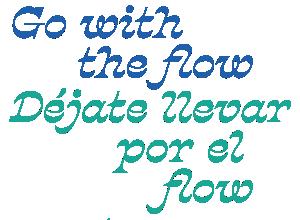
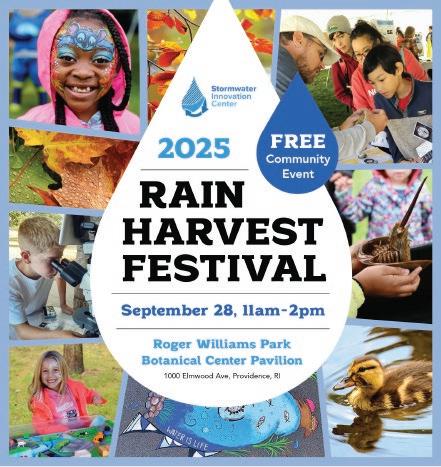
September 28, 2025, 11:00am–2:00pm
Roger Williams Park Botanical Center Pavilion, Providence
Music • Environmental Activities • Free Food • Games
Green Infrastructure Walks • Vendors • Arts & Crafts
For more information and a complete schedule of events, please visit: stormwaterinnovation.org/rainharvestfestival

Save the Date!



October 8, 2025
Roger Williams Park Casino, Providence Watch for details at stormwaterinnovation.org
Register now for these Audubon programs
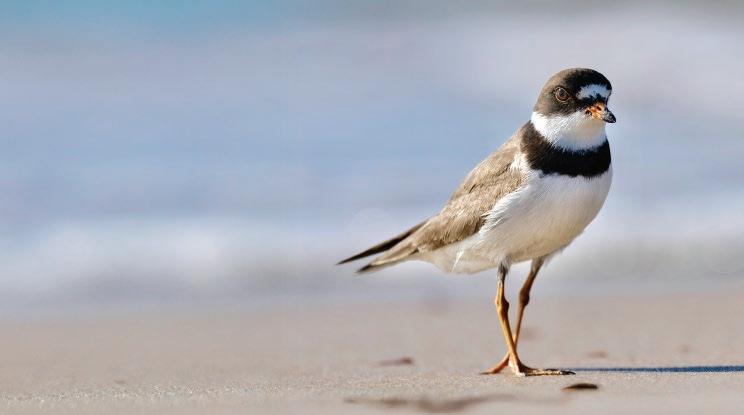
Visit asri.org/calendar
August 23, 2025; 9:00am–4:30pm
Join an Audubon van trip to Wolf Hollow in Ipswich, Massachusetts for a private tour of the sanctuary. Meet the resident wolves and learn all about these apex predators. Register early at asri.org/calendar.
August 27, 2025; 7:00am–3:00pm
Head to the shore with an expert guide and visit some of Rhode Island's best shorebird locations: Charlestown Breachway, Quonochontaug Breachway, and Succotash Marsh. Be prepared to get wet up to your waist for this program. Details available at asri.org/calendar.
September 8–13, 2025
Hop aboard the Audubon van for a six-day, five-night birding adventure to the Delmarva Peninsula. In early September large varieties of migrating shorebirds and songbirds may be found at the many places you will visit. The trip will cover the peninsula, from Chesapeake Bay to the Atlantic and the shore of Delaware Bay. Additional details at asri.org/calendar.
September 27, 2025; 8:00am–4:00pm
What better way to spend a glorious autumn day? Join Audubon for a fall birding adventure and visit different hot spots around Rhode Island with expert guide Laura Carberry. Search for songbirds, hawks, and ducks. Register today at asri.org/calendar.


Over a lifetime, many of us collect beautiful natural history artwork—original paintings of birds, handcarved decoys, delicate sculptures, and other pieces that reflect a deep love of nature. These works may hold special meaning, connecting us to time spent outdoors or to the artists who created them. But as the years go on, it’s not uncommon to wonder what will happen to these pieces when we’re no longer here to enjoy them—and to realize that our families may not share the same attachment or interest.
Rather than letting your collection gather dust or risk being forgotten, consider donating it to Audubon to be auctioned in support of conservation, science, and education. Your artwork can take on new life by helping fund habitat protection, wildlife research, and environmental programming for future generations.
Donating pieces from your collection is a meaningful way to ensure your love for nature leaves a legacy. Each sculpture, painting, or carving becomes a gift back to the birds, animals, and landscapes that brought you joy.
Audubon will be auctioning artwork through Copley Auction House of Boston in early 2026. Together, we can honor your connection to nature—and have your art protect the nature of Rhode Island.
If you are considering turning your collection into conservation, please contact Audubon Director of Development Jen Cleland at 401-949-5454 ext. 3018 or jcleland@asri.org.
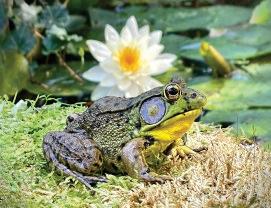
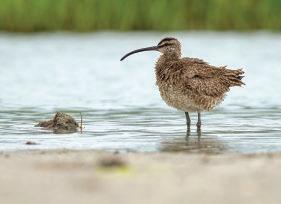

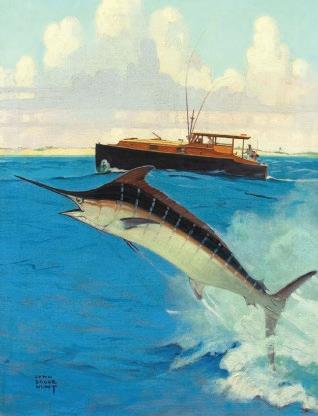

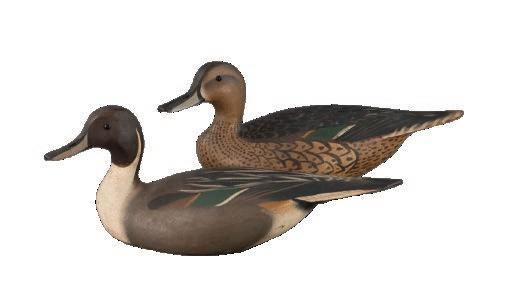
WE NEED YOUR PHOTOS
Audubon is looking for images of birds and other wildlife for the 2026 calendar competition. Note that we need photos that reflect all four seasons, and all submitted images must be taken in Rhode Island.
Deadline is September 15, 2025
Visit asri.org/audubon-calendar.html for details.
The second phase of the outreach project involved the creation of a self-guided tour brochure, styled like a traditional newspaper and distributed through a branded vintage newspaper box outside the Seal House. Park visitors can grab a brochure to learn about stormwater installations around Roosevelt Lake without the need for a SIC or Audubon staff member to guide them.
The outreach project was designed for a diversity of learners, allowing for more effective scientific communication. “Whether it is infrastructure, a set of educational boards, a newspaper, a postcard, an interpretative signage, digital materials, or a sculpture, the translation of intangible scientific concepts into material form are eye-opening for the lay public and are necessary to raise awareness of the effects of stormwater in our communities,” Menéndez said. “There is no one way of doing this, no magic format or equation. So, we need to try them all and reach people where they are in their communities, while supporting the different strategies and programming that the SIC team is implementing at the park and beyond.”
For those who are more digitally oriented, the third phase is in the works. The SIC has teamed with Assistant Professor Madison Jones of URI’s DWELL Lab (Digital Writing Environments, Location, and Localization) and his students to utilize innovative methods to communicate scientific concepts. In collaboration, the SIC plans to roll out an augmented reality component to its self-guided tour. Users will be able to take the walking tour while using an app on their mobile devices. Additional information, videos, and graphics will appear on their screens, engaging the viewer and highlighting green infrastructure sites.
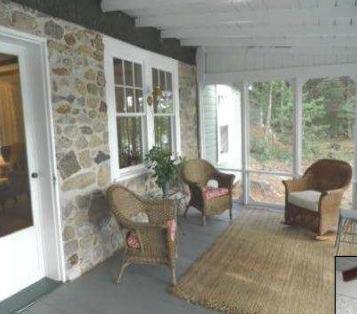
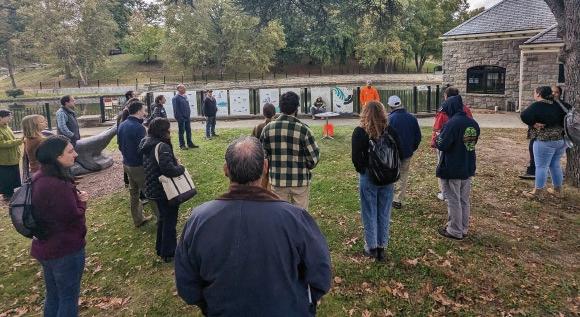
The impact of these outreach initiatives is significant. A fifth grade Sophia Academy student who recently took part in the SIC’s Stormwater in Schools program remarked “I’ve been to Roger Williams Park so many times, I even went a few days before the field trip. But I never noticed the green infrastructure…what we learned was important because some people don’t know what pervious and impervious means, and I didn’t, but now I do!”
The hope is that all park visitors who stop and read the signage boards or pick up a brochure, feel more connected to their surroundings and the ripple effects of their actions. And most importantly, that they understand their role in protecting water resources, resulting in a healthier environment for all.
If you are interested in checking out these features for yourself, come by the Seal House during park hours or view these outreach materials online at stormwaterinnovation.org/tours.

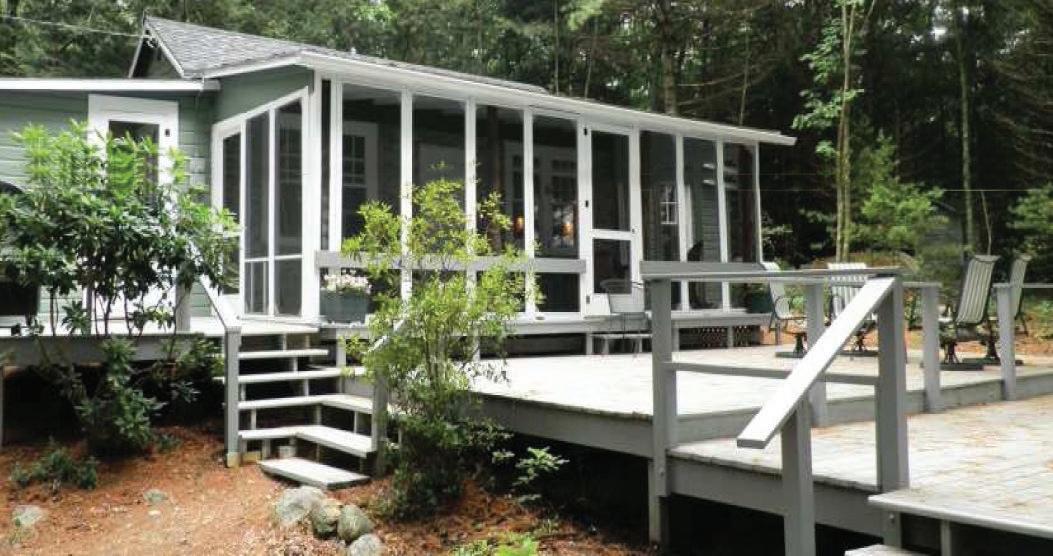
Rent the charming Maxwell Mays Lakefront Cottage for a weekend get-away or a family vacation. This beautiful fieldstone camp in Coventry has openings through October. For details and availability, visit asri.org/services.
By Dr. Charles Clarkson, Director of Avian
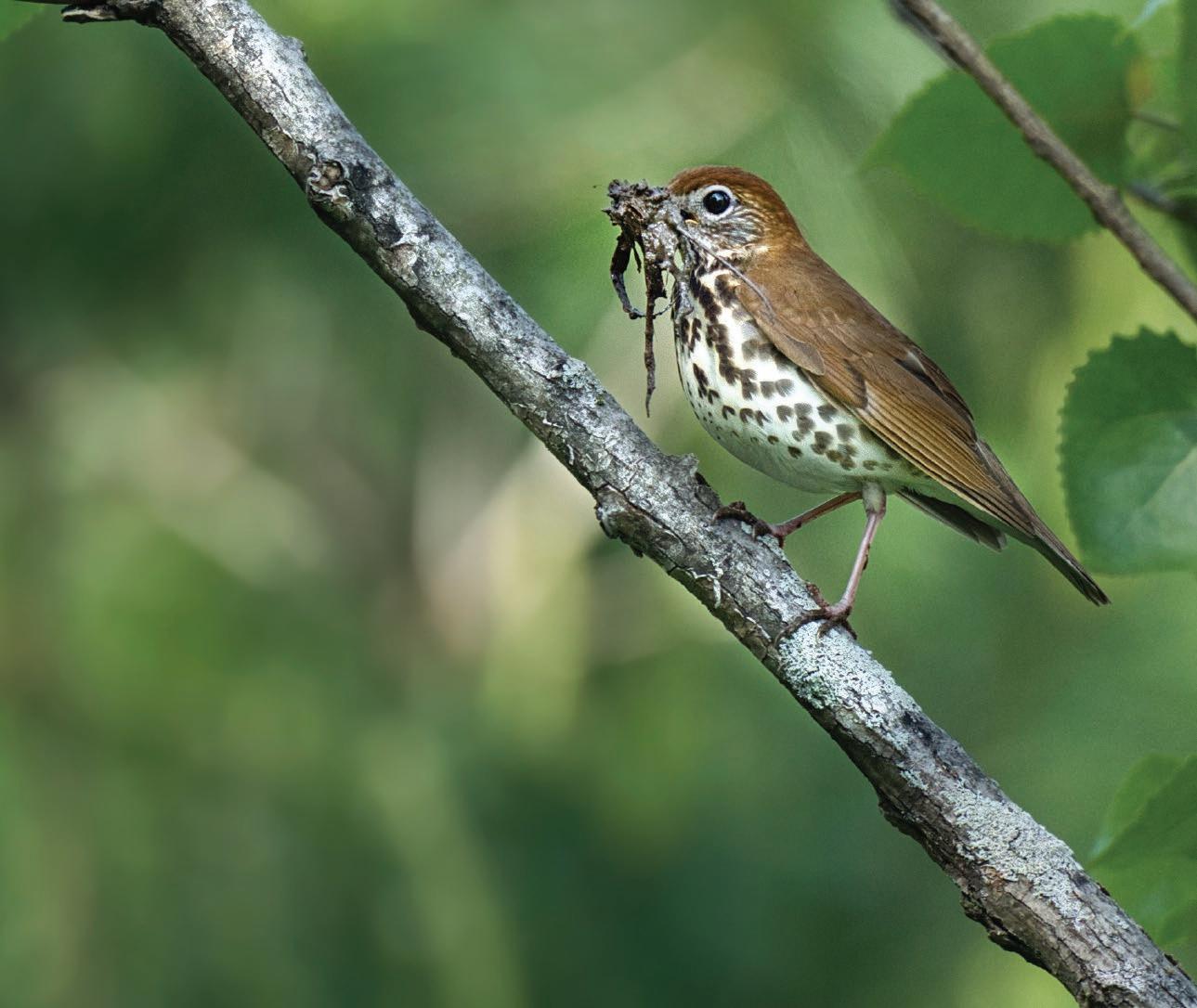
At a time when our government is redefining what it means to be an “essential” worker, it is important that we examine the role of ecologists and the critical work that they do.
Whenever I lead a bird walk, I often take the opportunity to explain to my group the very crucial distinction between the natural environment and the suburban or urban spaces that the preponderance of humans inhabit. A city is constructed by, and designed to accommodate, people. It is a space that caters to the needs of humanity – providing places for dwelling, working, eating and recreating.
A city does little to provide for the needs of any other group of organisms, except maybe rodents and cockroaches. A city is created by humans, for humans. In order to maintain the vast infrastructure of our urban habitats, a large and skilled workforce is needed – consisting of plumbers, electricians, carpenters, painters, engineers and many more distinctive professions.
As we walk in the woods, observing birds and their habitats, I like to make the distinction that these wild spaces, which are growing
less and less abundant as humanity’s insatiable appetite continues expanding, are not urban landscapes created by humans but rather are the places of our earth that in fact CREATED humans. Without them, and their inestimable connectivity that has evolved over billions of years, no single living thing would exist on this planet today.
So, as much as we depend on our cities and towns to provide us with the resources to live out our lives, the natural habitats of earth are essential to our well-being and indeed our existence. And, just as our urban fortresses require a suite of skilled human laborers to keep everything running smoothly, we have reached a point in our history where our natural spaces are in need of skilled laborers in their own right.
Hydrologists, who study the movement of water in relation to land, serve as plumbers for nature: diagnosing issues with water flow and devising ways to increase connectivity across the landscape. Ecosys-
We are sad to announce the departure of Dr. Charles Clarkson from the Audubon Society of Rhode Island. Charles launched the Avian Research initiative in 2021.
His work in bird conservation has been invaluable, not only in Rhode Island but across New England. He was an integral part of Audubon, and we wish him the very best.
The search will begin this summer for a new director of avian research.
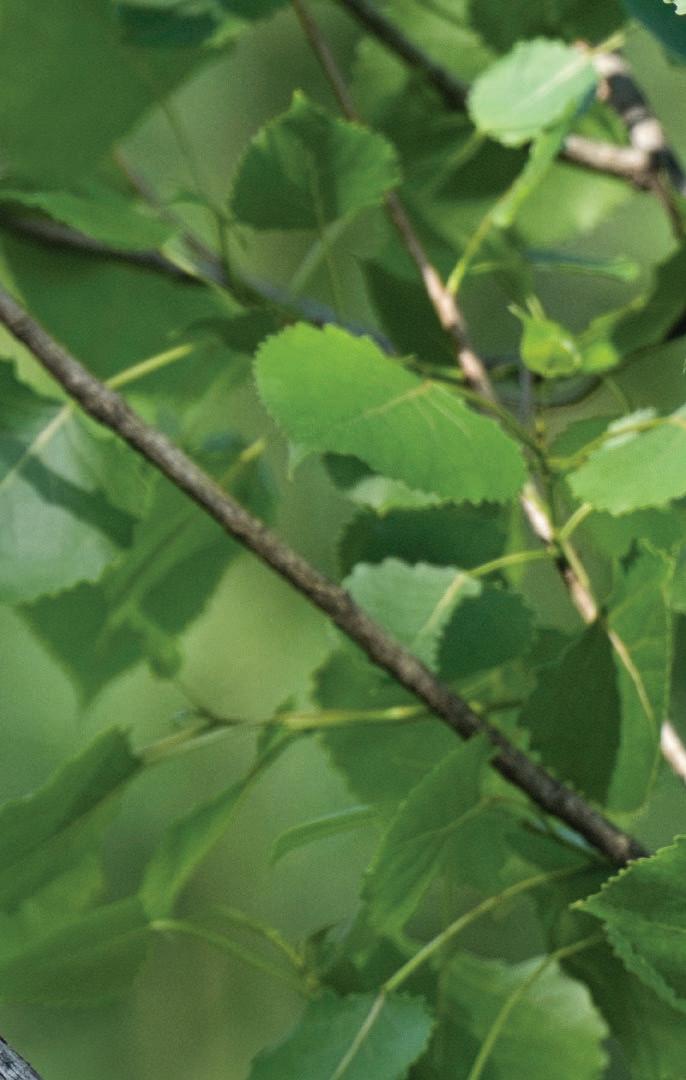
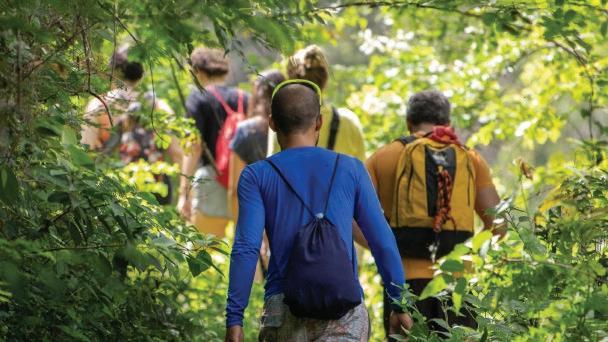
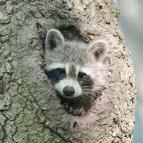
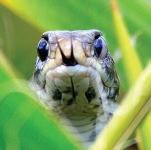
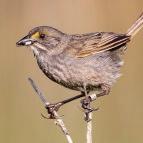
Let the experts be your guide to the ecosystems, plants, animals, and fungi found in Southern New England. Explore Audubon wildlife refuges with scientists and skilled naturalists who will provide both indoor lectures and outdoor investigations, culminating in a solid base of knowledge for beginner naturalists. Fee for six-session series: $300/ member, $350/Non-member.
All participants will receive a complimentary copy of Rhode Island Birding Trails.
• Introduction to Ecosystems
Audubon Nature Center & Aquarium, Bristol, RI
August 16, 2025; 9:00am–1:00pm
• Investigating Insects
Caratunk Wildlife Refuge, Seekonk, MA
August 23, 2025; 9:00 am–1:00pm
tem ecologists are the electricians of the natural world – studying how energy flows through communities and food webs and working to ensure that this energy flow is maintained and maximized.
As an Ornithologist who works mostly in the field of conservation biology, I am but merely an “aircraft mechanic.” The birds that I study are both the pilots and the aircraft. In my role, I work to keep these metabolic hotrods running smoothly by understanding what fuel types are best at powering their long and arduous flights and then ensuring that these fuels are available in requisite quantities at the landscape scale.
All of us who have devoted our lives to the service of wild habitats, wildlife and ecosystems are, in essence, working in a service industry. And we are working to service the needs of the life-support systems for our planet. If humanity were to disappear tomorrow, nature would rebound – its capacity for recovery after insult is unparalleled. But, until then, as many humans work to undue the intricate linkages of our natural world, ecologists and conservationists will be there to identify problems, diagnose ailment, and mitigate loss. SUPPORT THE AVIAN RESEARCH INITIATIVE
• Identifying Plants & Trees
Fisherville Brook Wildlife Refuge, Exeter, RI
September 13, 2025; 9:00am–1:00pm
• Beginning Birding
Fisherville Brook Wildlife Refuge, Exeter, RI
September 20, 2025; 9:00am–1:00pm
• Mammals of Rhode Island
Powder Mill Ledges Wildlife Refuge, Smithfield, RI
October 4, 2025; 9:00am–1:00pm
• Fungi Foray
Fisherville Brook Wildlife Refuge, Exeter, RI
October 11, 2025; 9:00am–1:00pm
For details and to register, visit asri.org/calendar.
Audubon Society of Rhode Island
12 Sanderson Rd, Smithfield, RI 02917
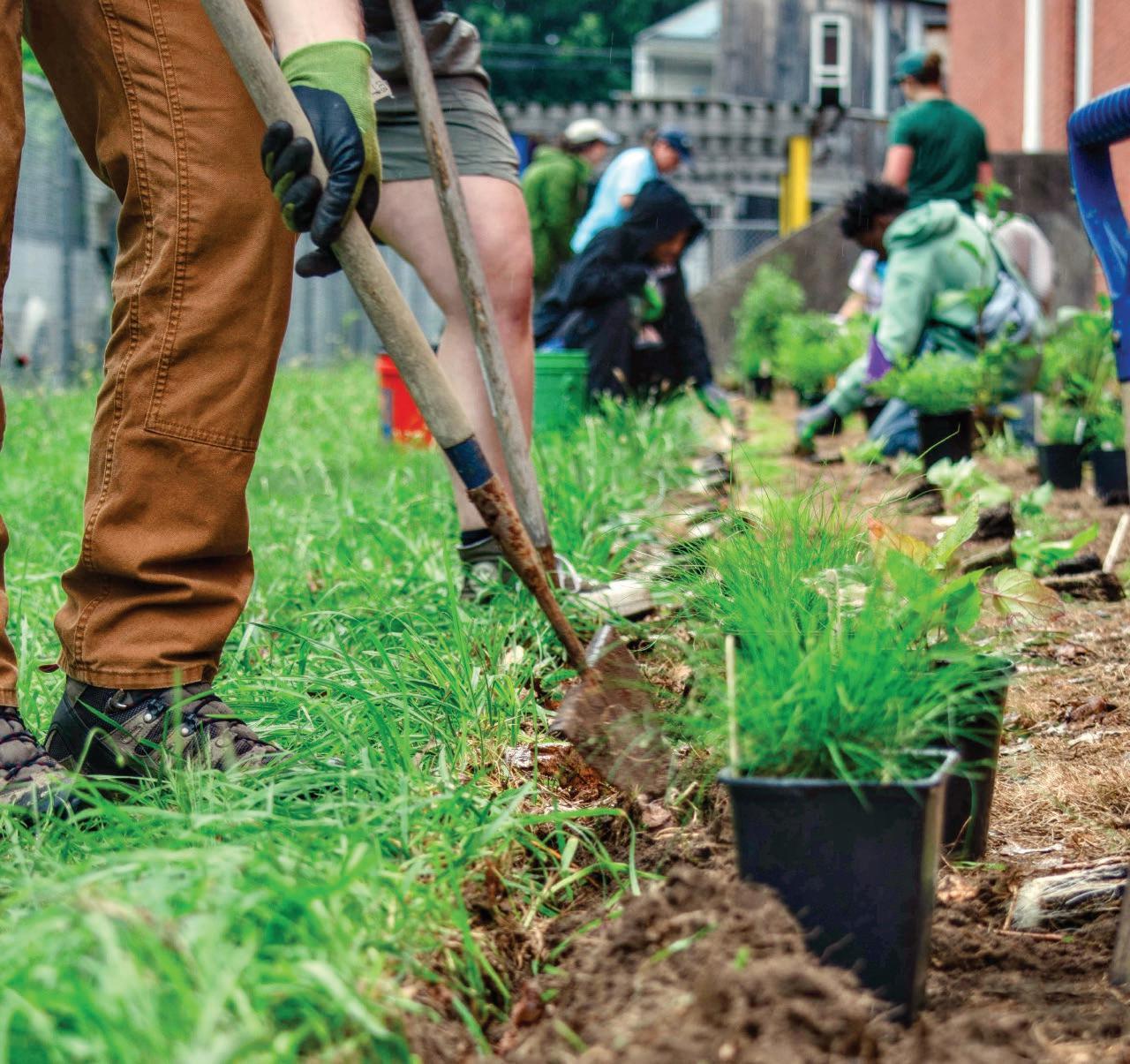
In June, 20 volunteers joined Audubon TerraCorps Member Autumn Jencks at the South Side Providence Boys and Girls Club and used over 175 native plants to create a community pollinator garden. Audubon’s goal is to inspire curiosity about the critical role that pollinators play in food accessibility and share how native plants can help mitigate the impacts of climate change on local wildlife.
Support our work. Visit asri.org/donate.
Special thanks to individual donors and project sponsors Bloom RI, The RI
and the Awesome Foundation.